Sorry for not publishing the last week – there was so much work to tackle. But that also means, lots of exciting articles coming up in now. As workload dropped a bit I seized the chance to fulfill one of the things still open, one of the things I wanted to do for a long time. You may have recognized that I put a little focus on Linjett yachts recently with some very interesting articles on the shipyard, their approach to building quality and also their amazing history. Well, it´s one thing still open: Finally answering the question of how does a Linjett yacht sail?! Well, I´ve got the answer now.
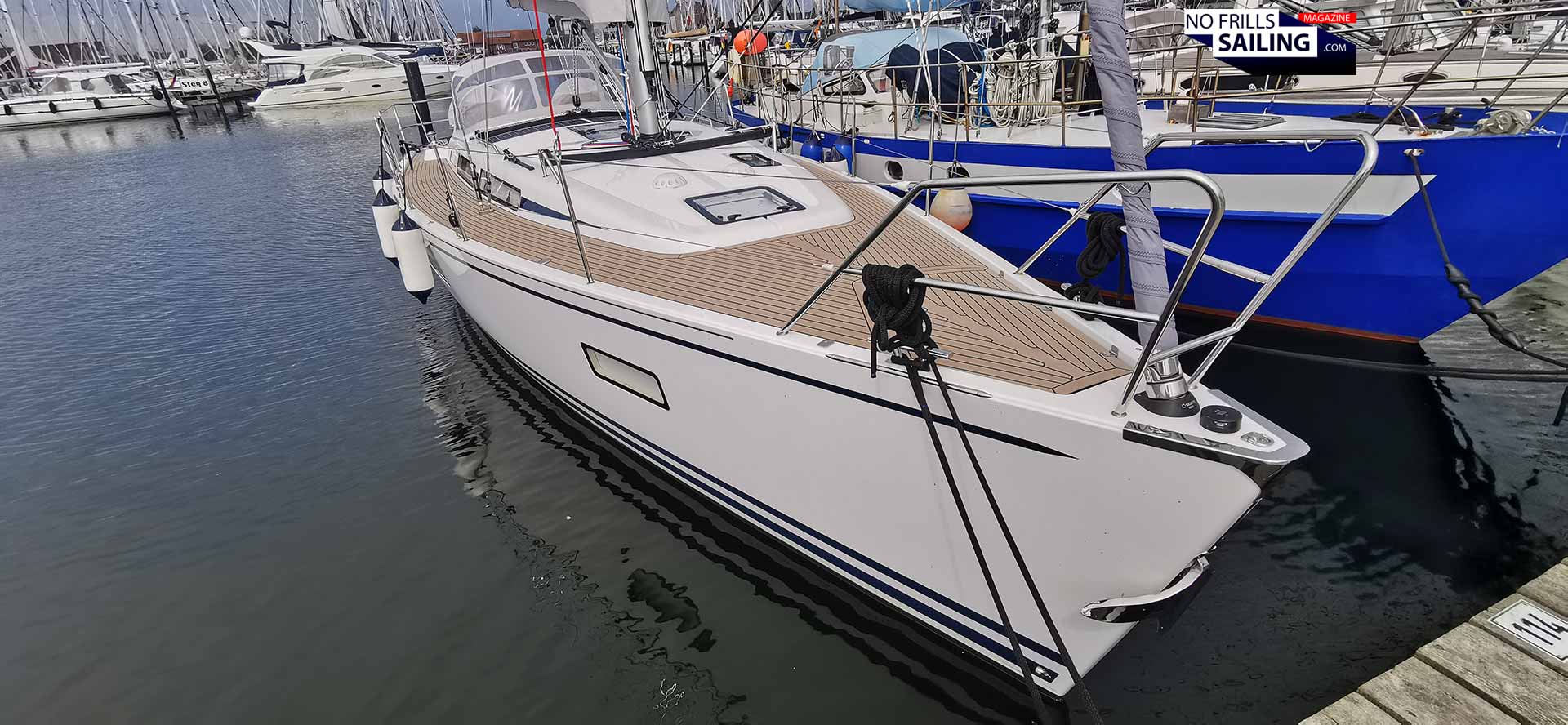
Last Saturday weather cleared up, turning a series of strange hot misty rainy days into a nice based summer´s day. Clear blue skies, a bit of wind: Perfect for a sea trial, right? I was happy to having met Thomas Schwarz a few weeks ago. Thomas owns a Linjett 39, the one that had been on display at the very same boat show where we presented hull #401 of our newbuild Omega 42. As we were neighbors that weekend, we´ve had a little chat and finally invited each other for a dash out in our respective yachts. Well, it will take a few months until I can receive Thomas aboard ALPHA, so I started visiting him.
One last thing open to check …
His LOBSTER has her home port in Heiligenhafen (you may translate it loosely into “Holy Harbor”, one of the hot spots of sailing near the Island of Fehmarn. It´s always great to come here since I learned how to sail here and have quite a number of nice sailing memories about Heiligenhafen. There, on the last pontoon of the bis marina, I found his beautiful boat, right in the last berth – a perfect berth, by the way. Thomas greeted me warmly and without wasting any more time of this wonderful Saturday morning, we decided to go out and sail right away.
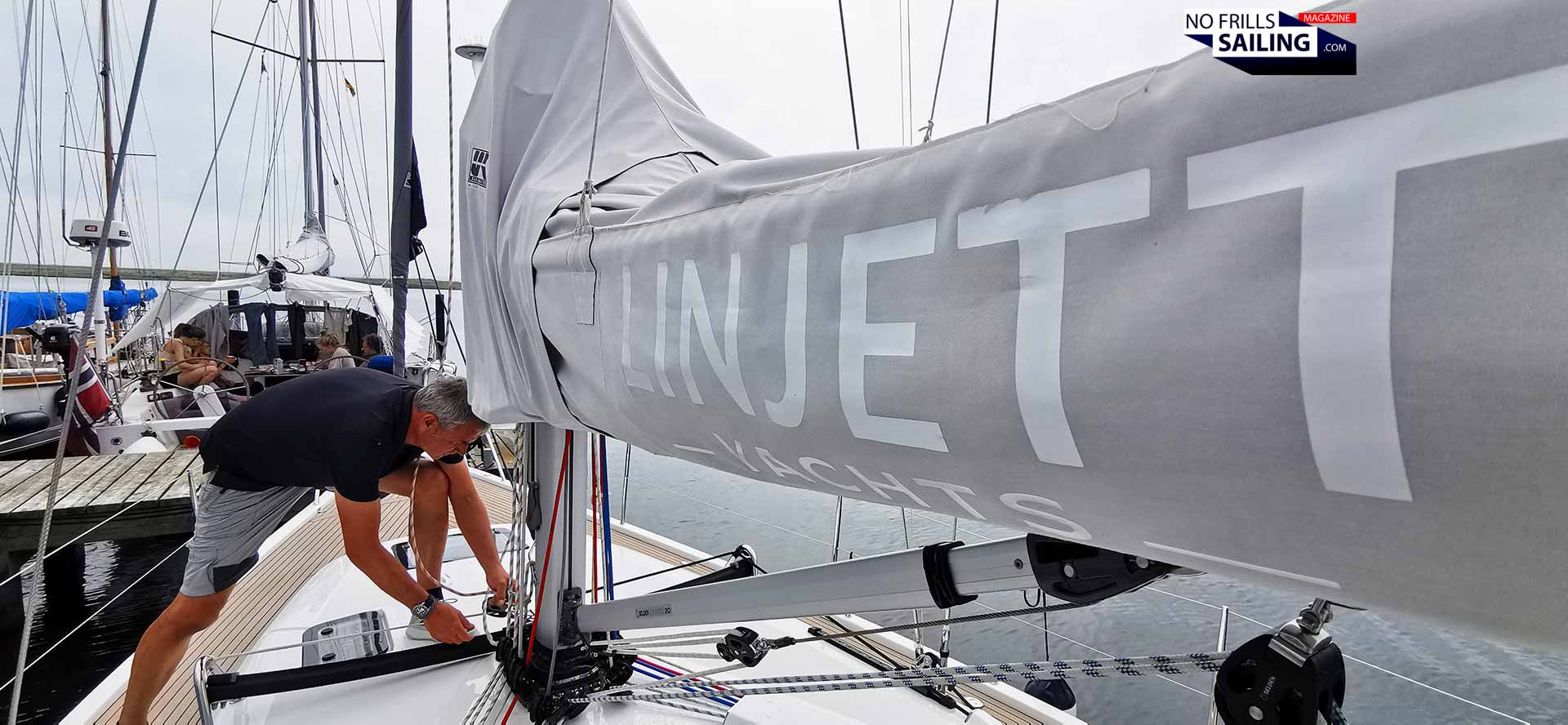
The Linjett 39 is the second largest boat of their current range of products. Linjett offers a 34-footer entry level sized boat, the brand new 36-footer which is currently under scrupulous testing before the official premiere. Then in the upper range there´s the 39 feet yacht which I am about to sail now and their flagship, a 43-footer. These yachts are optimized for cruising and, if you don´t know the brand as of now, can be described as classic, luxurious Scandinavian-style yachts for perfect cruising. But later more on that.
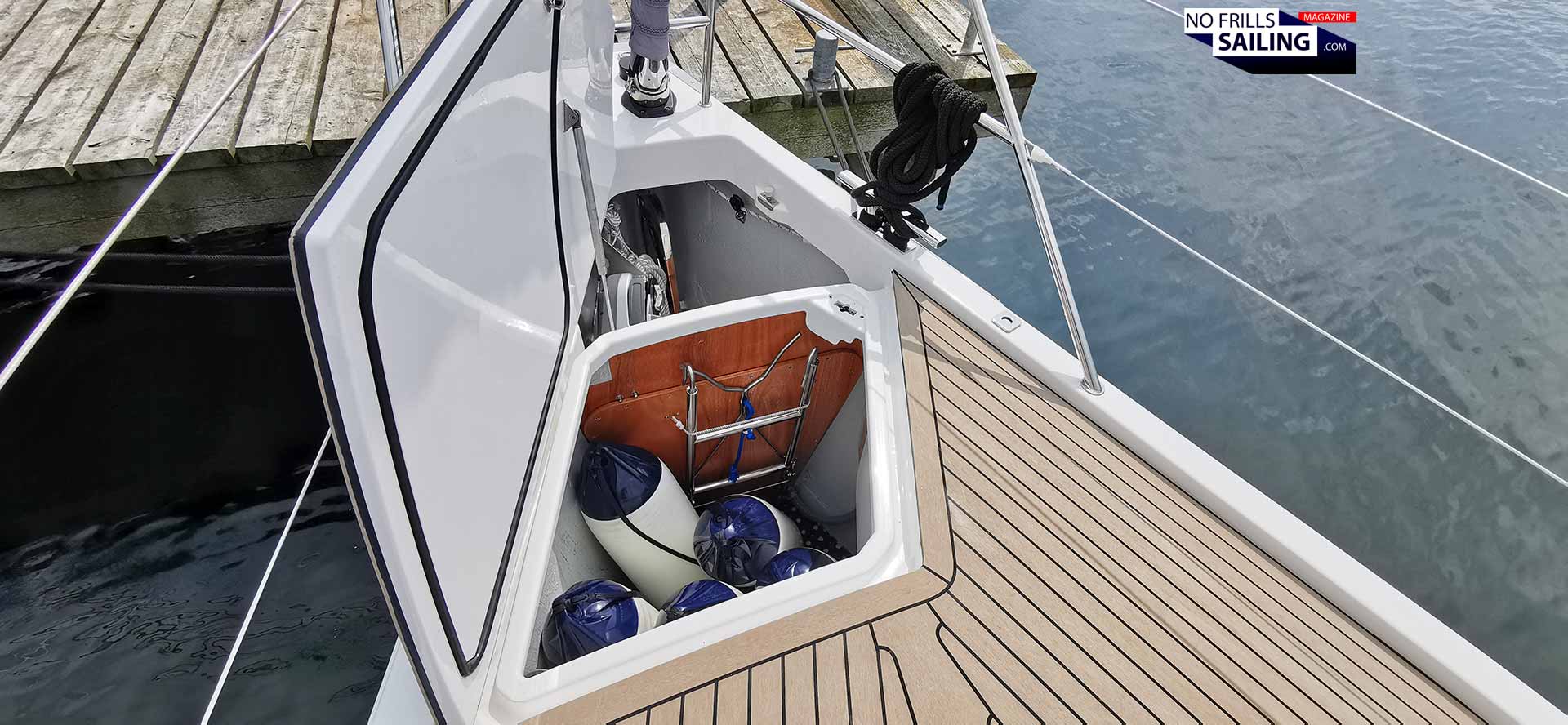
Readying the boat to go out was a matter of minutes. Thomas´ berth is absolutely perfect: Located at the end of the pontoon, we just had to take away the mooring lines and a smooth puff would make us drift sideways out of the box. Before we could pull off this elegant maneuver, Thomas removed the sails cover from the lazy bag, connected the halyard to the mainsail´s head and started the engine. Vis-à-vis from us a guest boat from Norway had been moored. A nice sympathetic family of five. Enjoying a late breakfast, the adults smiled and nodded as we slowly drifted from out berth, wishing us a nice day. Takk!
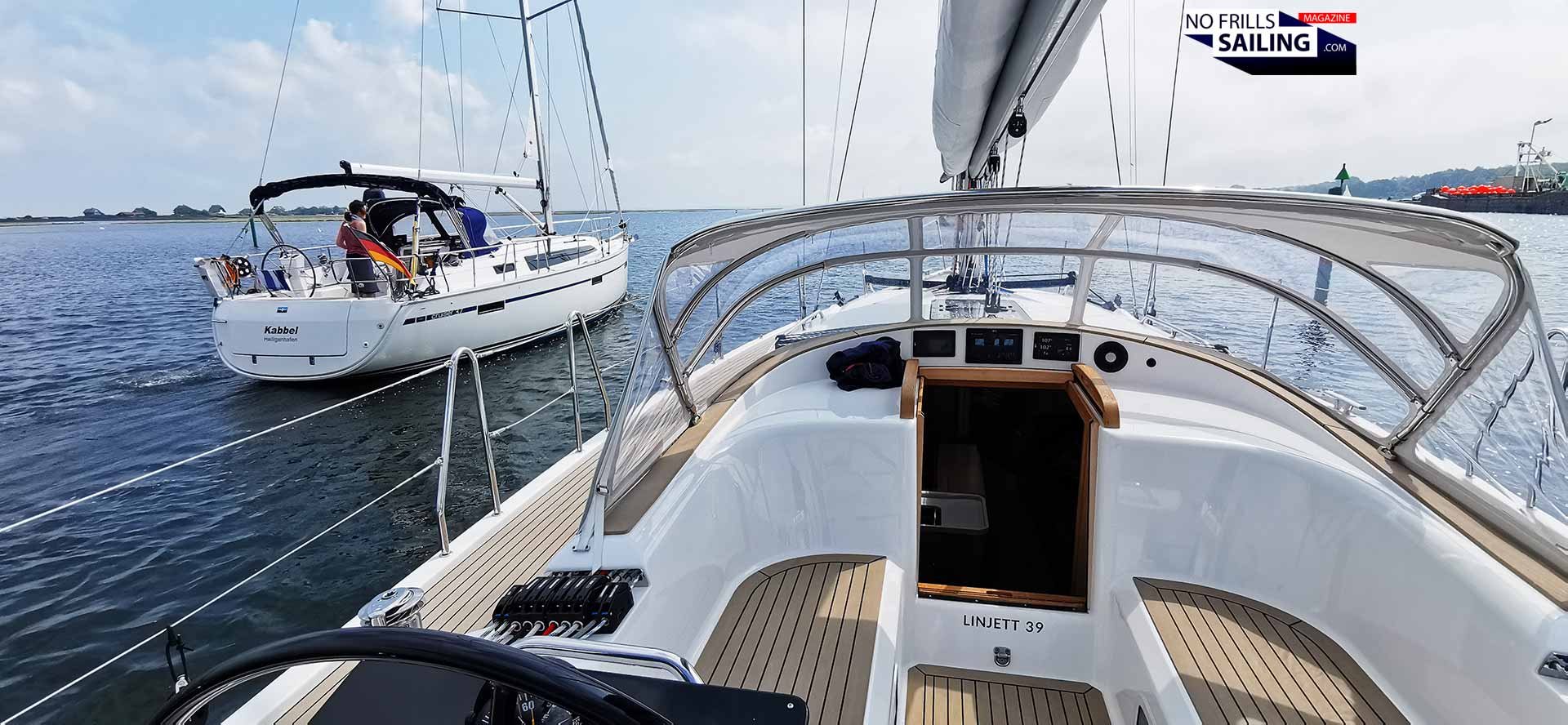
It´s so much different to be on a yacht of such a building quality. For a start, there are these tiny details, like for example the huge bow locker where I stored the fenders. Not the size (which in itself is a nice surprise for this boat size), but the fact that it opens by pushing a button, slides open effortlessly by gas props. It makes working the boat so much easier. Much more in face of the fact that most people cruising are lone couples. The Linjett if full of these little neat helpers, up on deck as well as down below. No frills, but practical details, developed and integrated with decades of feedback and knowledge of Linjett´s customers – the sailors.
As quick as a daysailer
39 feet, that´s an overall length of 12.15 meters, a waterline of 11 meters. With 3.95 meters width she is definitely not a small yacht. Nevertheless, she almost feels like one. The whole idea of the boat is to make sailing very easy and effortless. We will look a bit later more into the cockpit layout and winch design. As for now: Getting up the sails and underway was a sheer no-brainer.
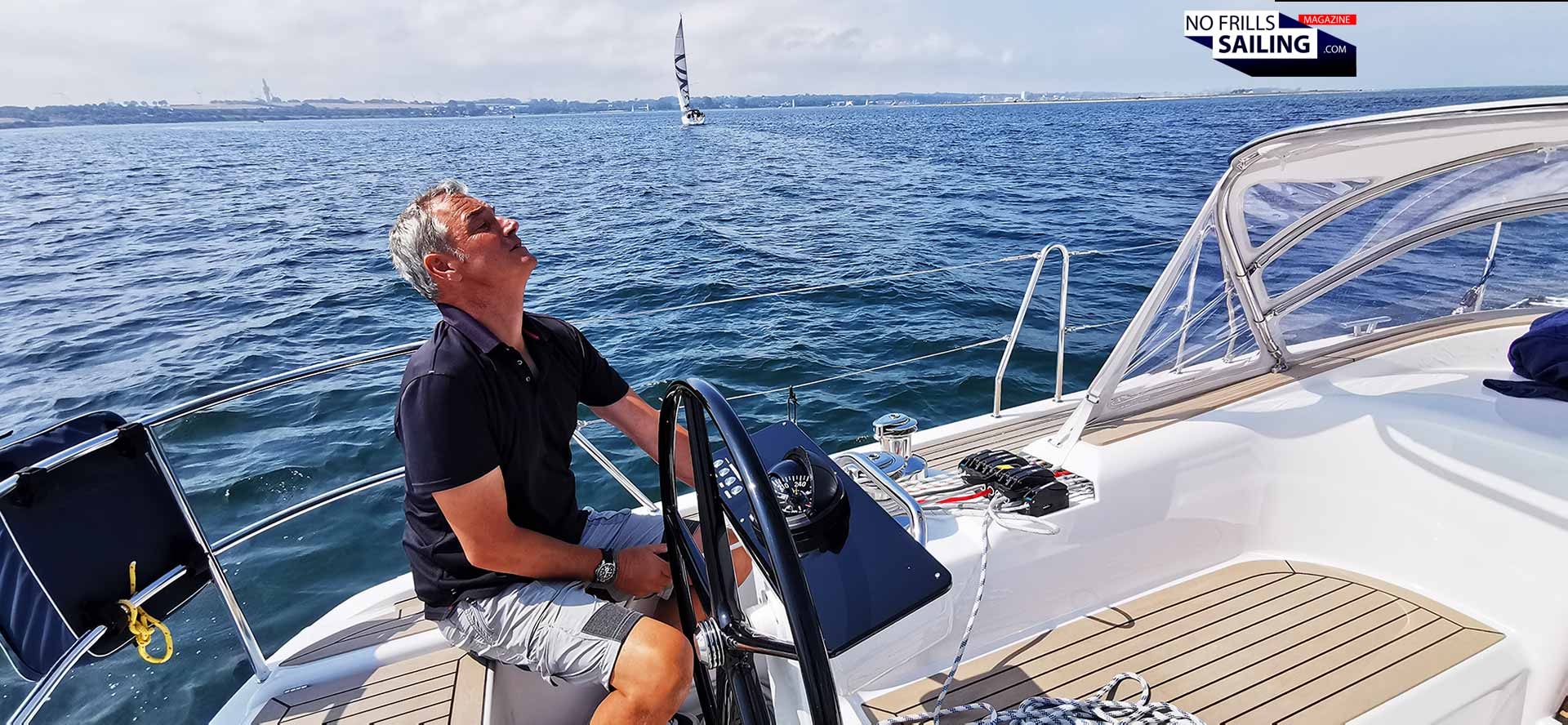
Thomas sat on the side, steered the boat into the wind and simply pushed a button. The mighty 52´Andersen winch hauled up the mainsail in a matter of seconds. I mean, this may be a matter of course nowadays, but I can still vividly remember when turning the cranks to get the main hoisted had been the first real work of a day out sailing. Now I´m 46 years old and I simply cannot imagine to accept this kind of work on my own boat anymore. Are there really boats out there without even one single electric winch? Except for cheap charter yachts, of course …
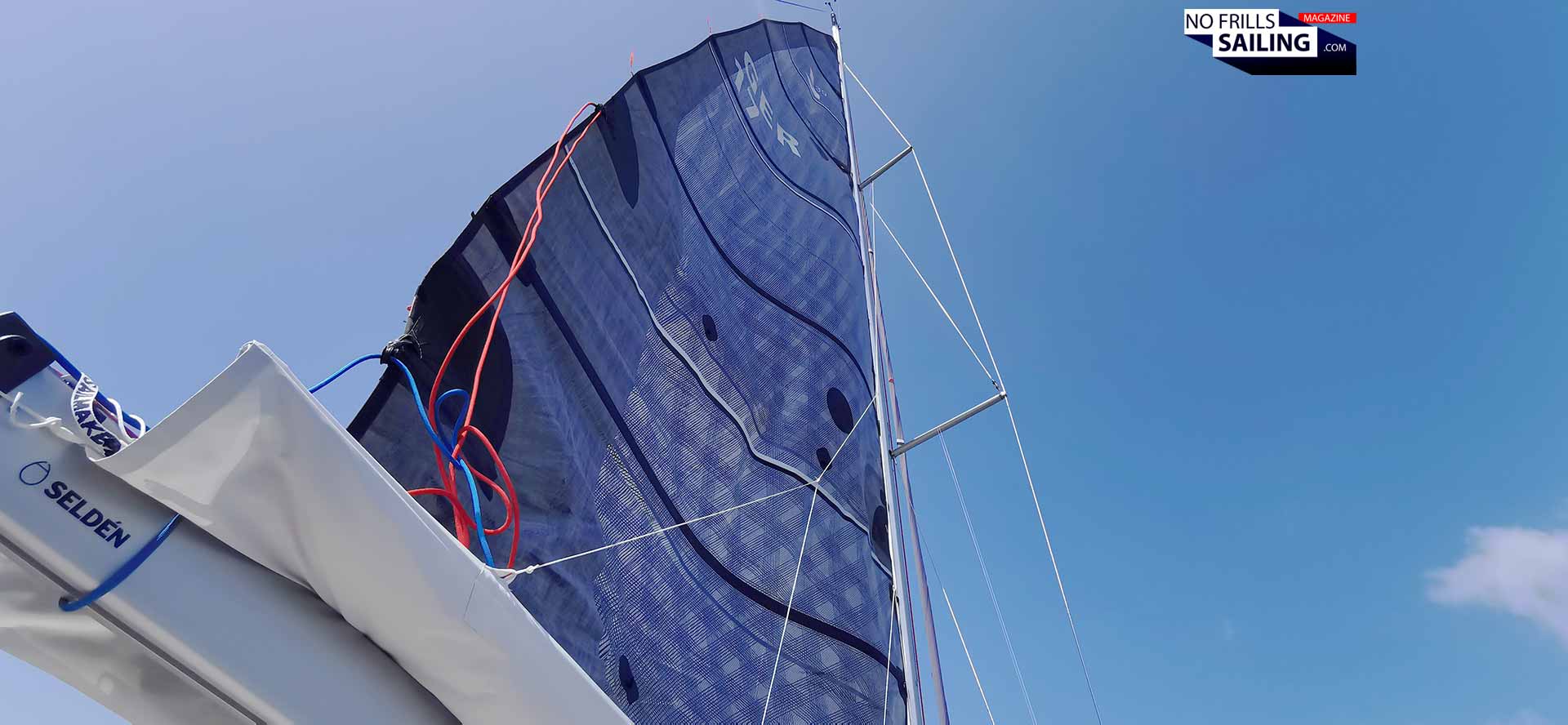
So, don´t even hesitate to think about whether you get one or not: Get one! Electric winches, at least the one that hauls the main sail, should be a common standard on boats larger than 36, 38 feet. My opinion. After the main had been hoisted, I veered away and sheeted in the sail so that it caught some wind. The boat heeled a bit and I felt that it was enough to drive her, so I killed the Diesel engine as Thomas went on to unroll the Jib.
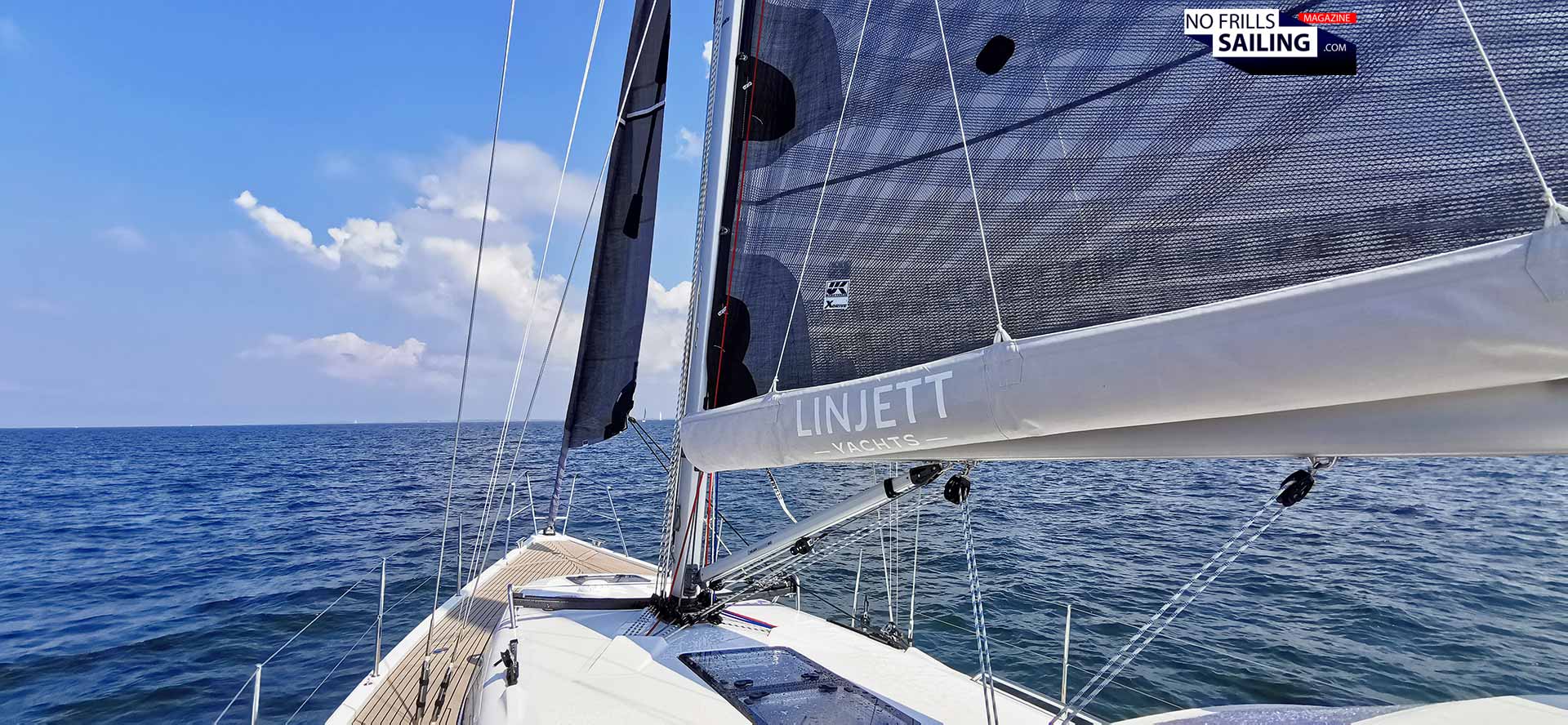
The Linjett can be ordered with a 34 square meters self-tacking Jib (which we´ve had out that day) and a 107% overlapping Genoa with 38 square meters more. Thomas said he went for both, but fancies the Jib because for normal cruising it´s the more convenient sail: Easy to utilize, fairly powerful and if wind drops below a certain threshold (which we were about to experience later that day), it´s the lightwind sails which will drive the boat much better than a just 4 square meters bigger Genoa.
Don´t save on the sails!
Speaking of which, let´s have a word on sails. Thomas went for the X-Drive Carbon Taffeta sails by UK Sailmakers. Linjett is affiliated with UK Sails, so you get these ex works with you new boat, but as an ex-salesman for Beneteau I can tell you that most people acquiring a new boat still save on the quality of the sails. OEM sails are usually of inferior quality even if provided by high class brands, at least that´s valid for most of the big production boat companies. Don´t do that.

Seeing how nicely LOBSTER accelerated was a testament to the fact that you should never save on sails for you sailboat! Even if she´s “just” a cruising yacht used for vacation, a decent cruising laminate sail is so much more fun, has so much more power and will bring you boat so much better to life than those cheap standard Dacron flannels usually coming with the new bought yacht in standard. You shouldn´t necessarily opt – like Thomas did – for the upper shelf quality of course. But most renown brands will offer a very decent quality for cruising sails: Cruising laminates and membrane sails that have a great performance and will last long. What a difference good sails are indeed making can be seen especially on boats which aren´t necessarily known for great performance, like your ordinary volume cruiser. But back to LOBSTER.
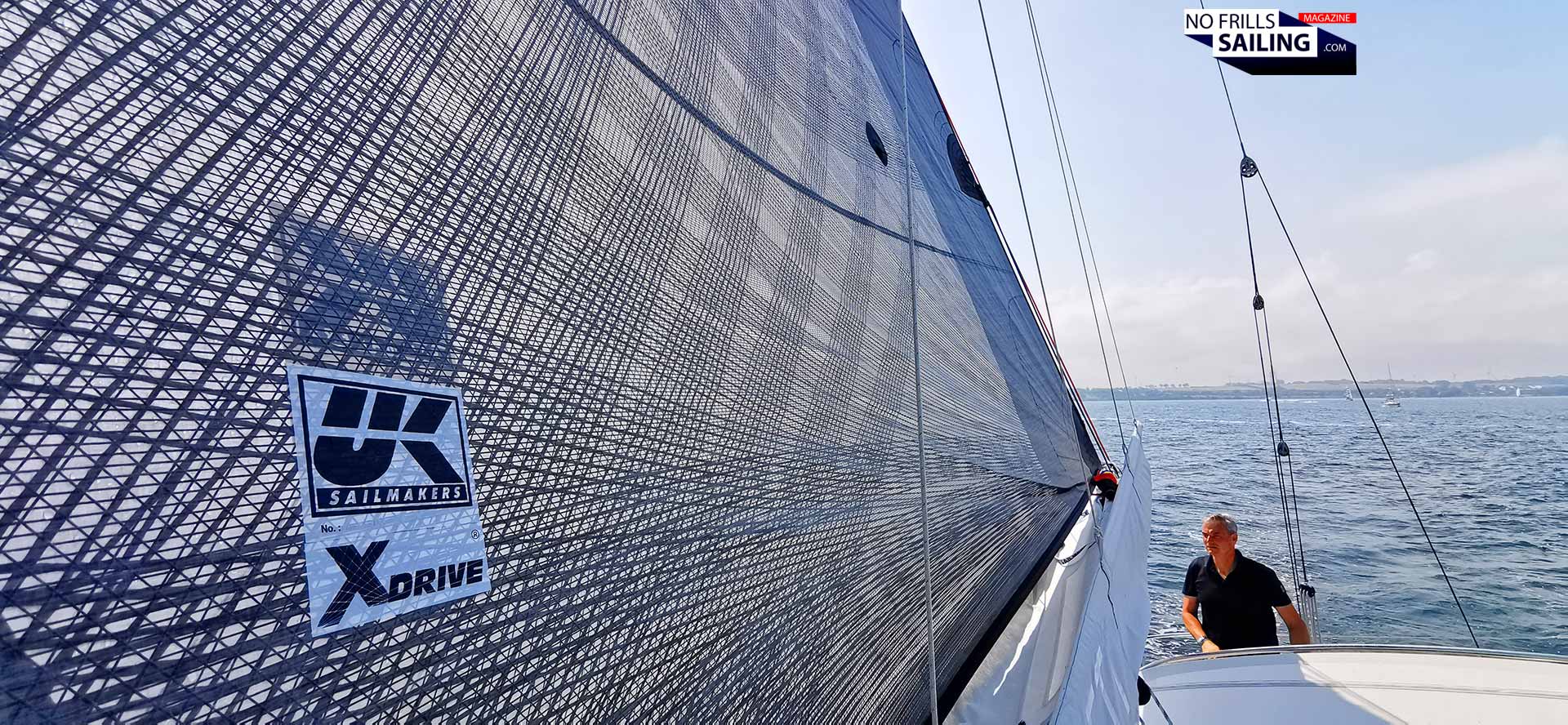
Once the sails are deployed and trimmed, the boat heels over ever so slightly and starts to accelerate. Conditions are just perfect that day: Just a nice 11-12 knots TWS wind blowing out to seaward from the land, meaning there´s virtually no waves going on. In these conditions the Linjett is a bit underpowered with the Jib. Her 8.5 tons displacement could need a bit more canvas, although the just 4 square meters bigger Genoa wouldn´t do the trick here either, I suppose: This is a case for a proper Code 0 light wind sail, which we hadn´t aboard with us.
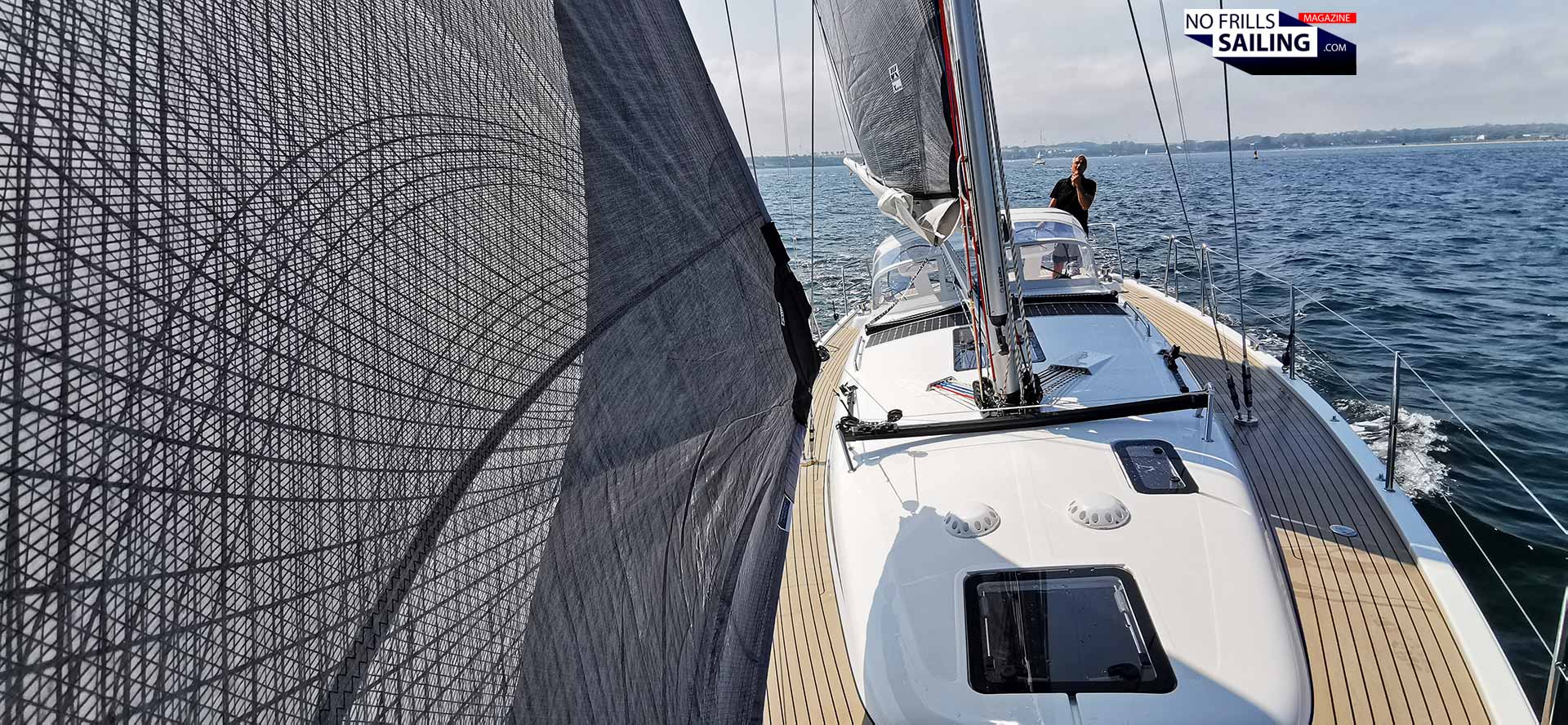
Anyways, wind was more than enough to have LOBSTER going at 5.5 to 6.5 knots SOG, which I found pretty impressive given the light conditions. Thomas let me have the rudder and I started to get a feel for the helm at first. What was pretty clear from the onset was a nice direct feel, even though te Linjett 39 is equipped with a double wheel helm station. That means, underneath the cockpit deck are mounted the Jefa steering mechanics, consisting of cables, the quadrant and fixed parts. Of course you cannot expect the very direct and unfiltered feedback you get from a simple tiller steering, but the flow of water passing the single rudder blade indeed created very apparent feedback. This will, when sailing faster, be very valuable to find the perfect edge. I then started to bear away and sheet in again to see how she would behave on different points of sails.
Testing the sailing capabilities of the Linjett
First of all, the helmsman´s positions. As I´ve already mentioned, the Linjett 39 comes with double helm stations, each equipped with a display panel case. This I find a bit odd, at least the one to port side, as it hadn´t been equipped with anything else than four buttons and the magnetic compass. Maybe Thomas will fit a secondary chart plotter here in the future, I´d recommend to have it done ex shipyard. Nonetheless, the ergonomics of the helm stations are exemplary.
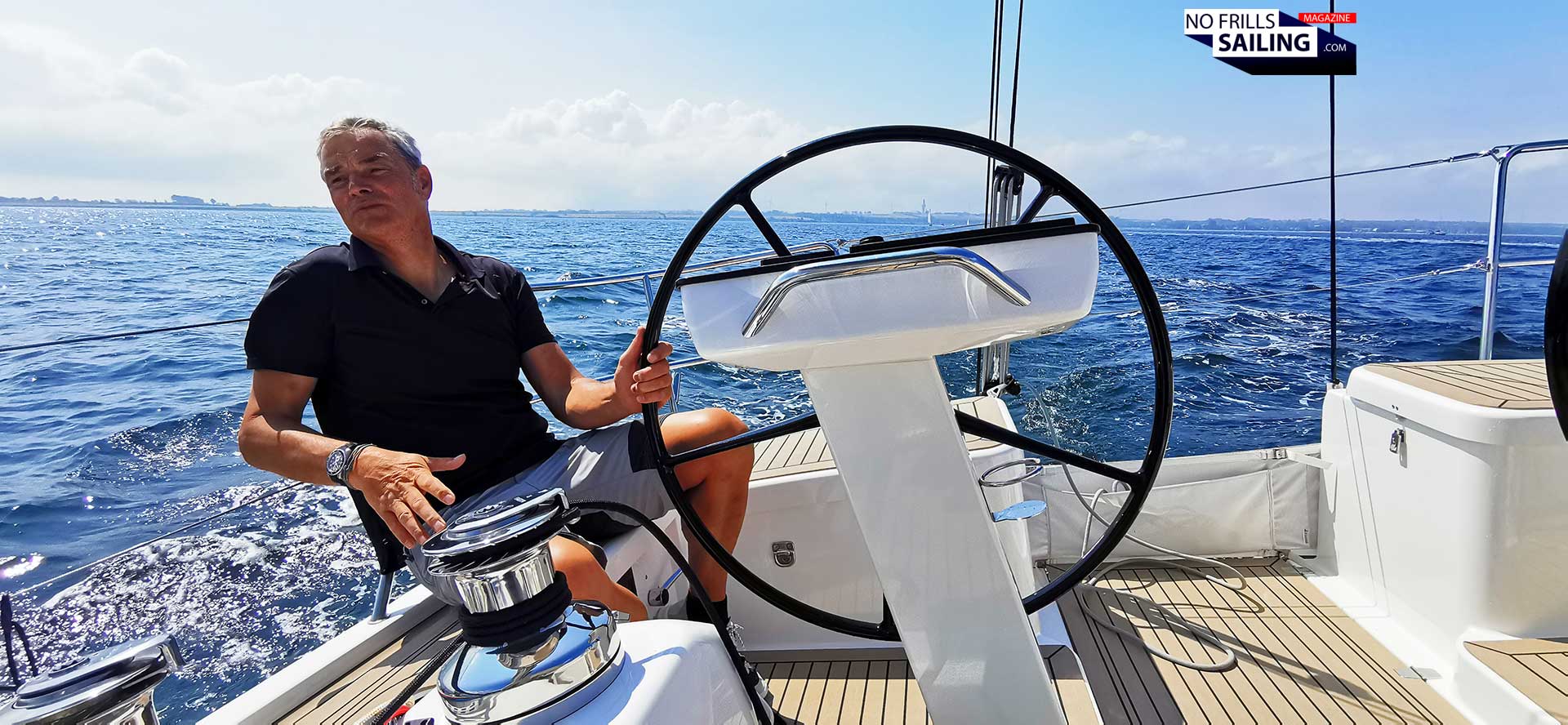
You may take a seat right behind the steering wheel, which is usually done when under engine. When sailing, making yourself comfortable on the coamings is much better. Thomas loved to take the leeward helm, I prefer the windward helm station. When taking over the steering from Thomas there, I would say you just need some sort of cushion and a backrest, maybe two fenders or custom fitted cushions, and it´s a perfect location to really dive into sailing – a perfect thing. Like meditation and really immersing into the present, I sat there and held her on her due course. How much nicer can it possibly get?
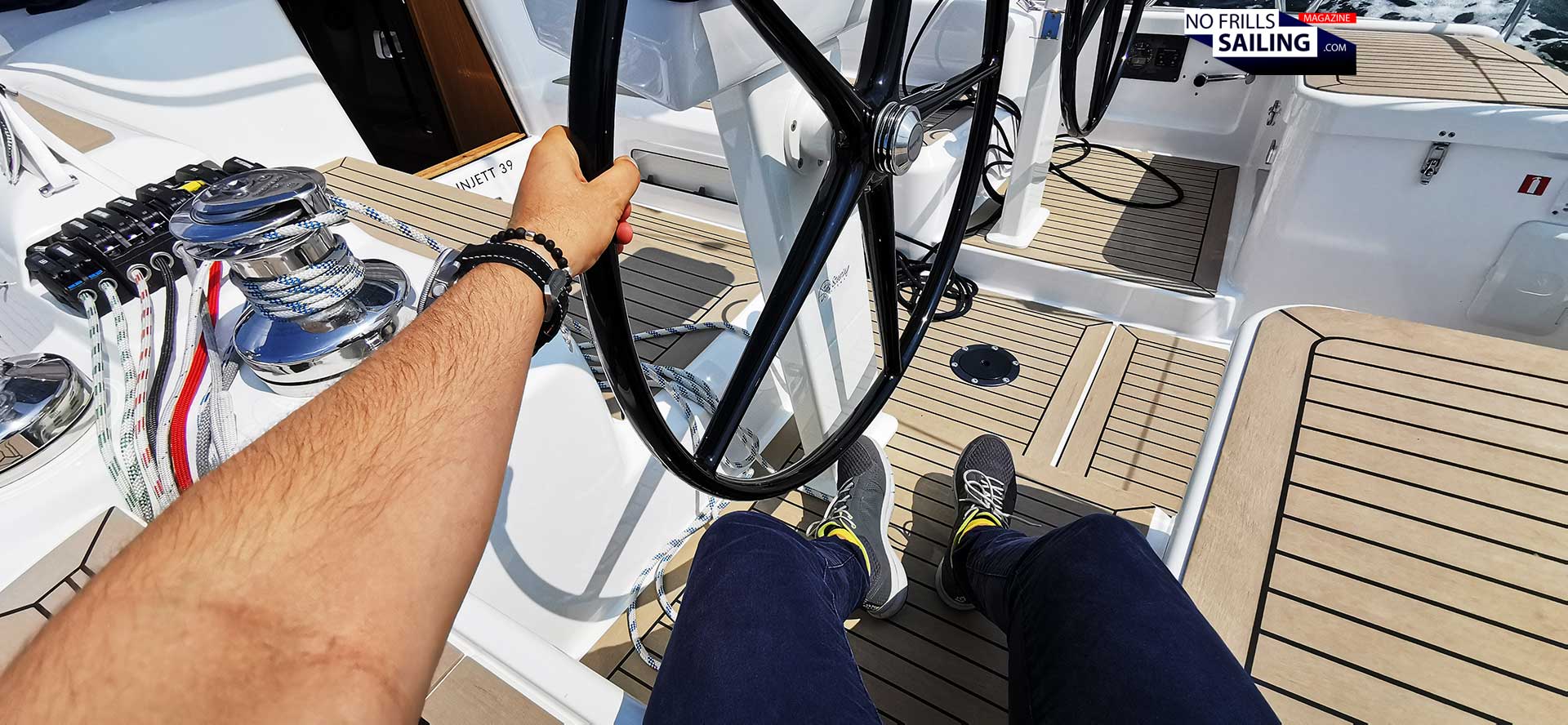
That day, with just 11-12 knots of wind and virtually no movement of the boat or any more heeling, all was fine. I imagine that a footrest, a wooden stopper or adjustable parts on deck to countr-balance the heeling would add some extra stability and safety here. Apart from that detail, I found it pretty awesome and there´s nothing to add just as: Well done, guys!
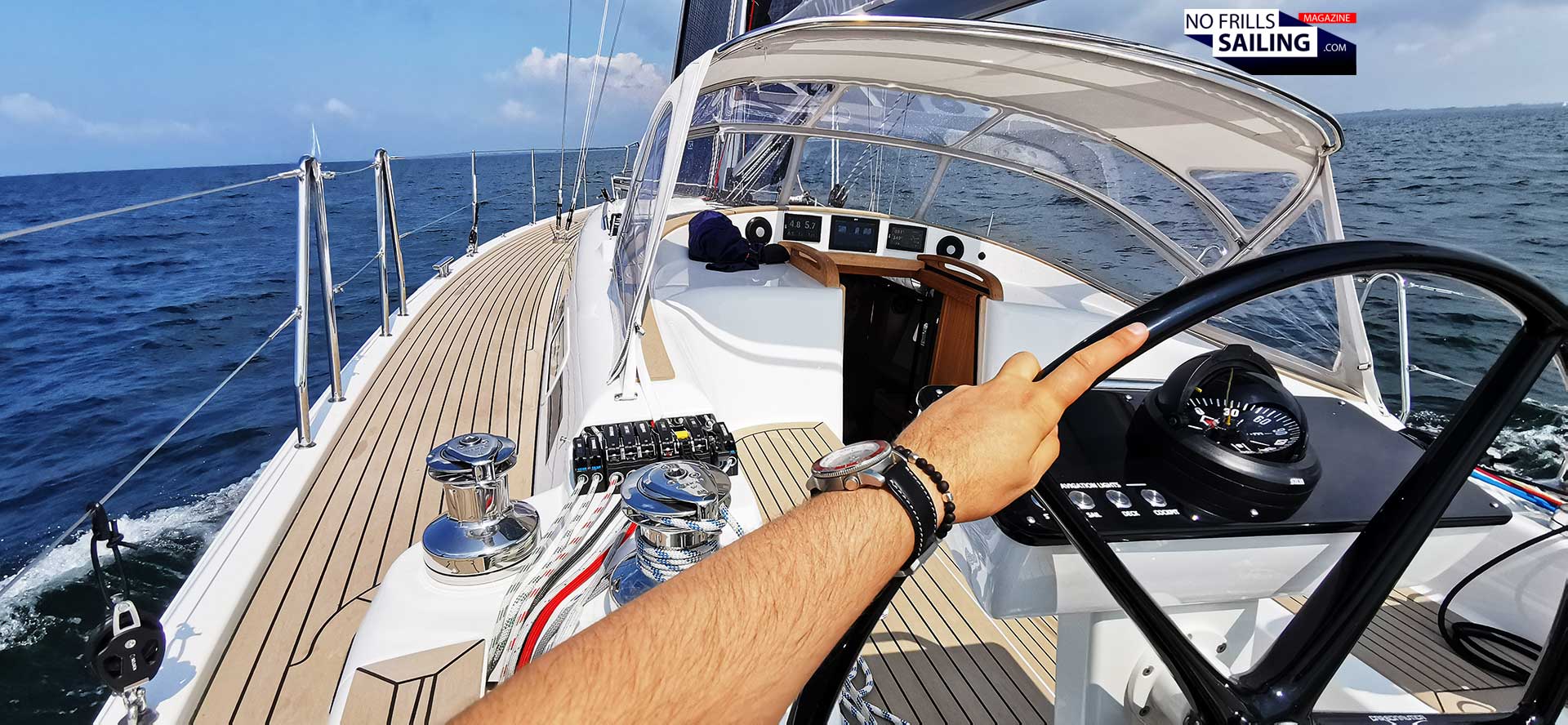
The forward view for the helmsman over deck and the walkway is brilliant. Linjett comes with a nice high quality sprayhood that has far more transparent parts than canvas, which makes it even easier to also have a mostly unobstructed view to windward. Part of the reason why the view is so perfect are the shrouds of the Linjett 39, which are not fitted to the outside of hull but enter through the inner side of the deck and are connected to the chainplates well within the boat. As you can see in the picture below …
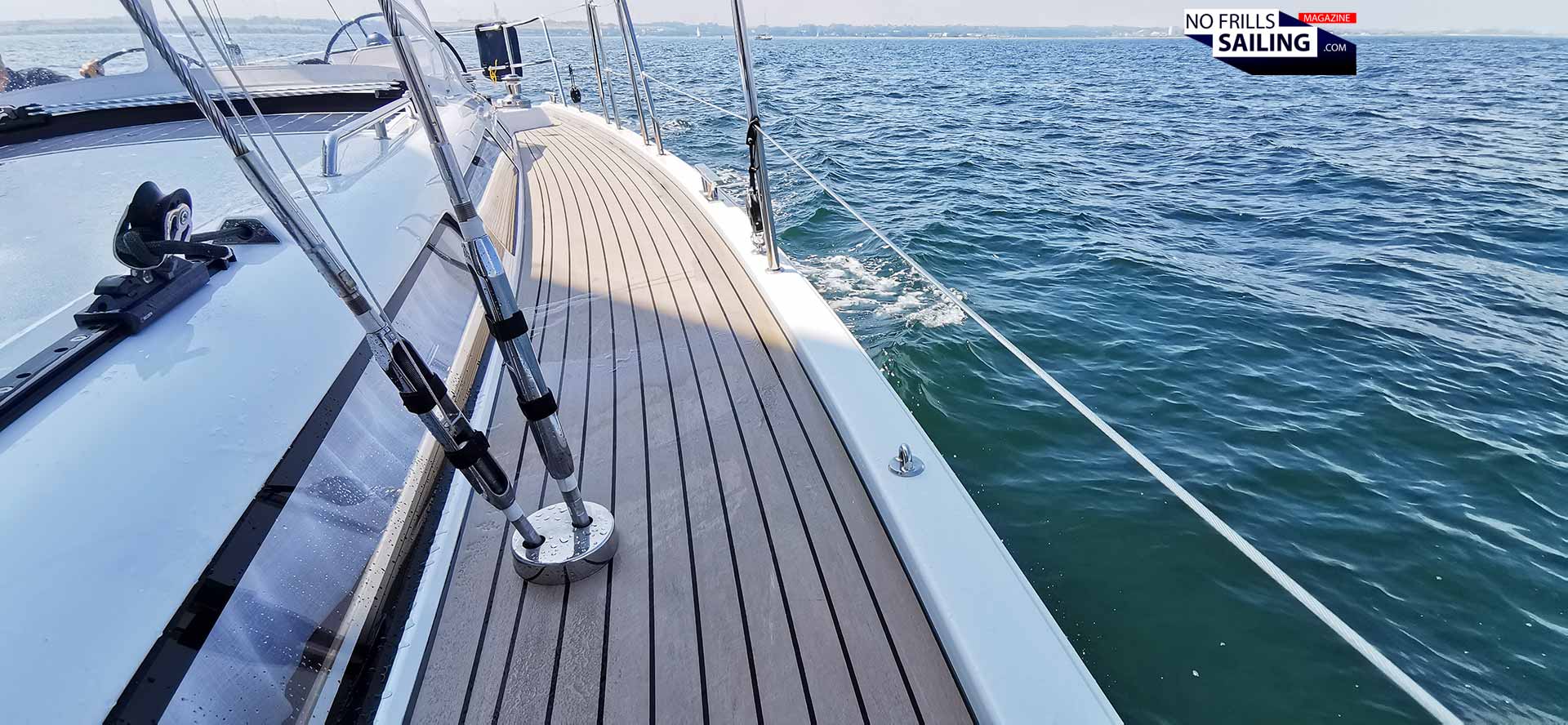
… it makes the view very clear, especially to windward. There I spotted a 35-footer under full canves and started a little experiment. How fast can the Linjett 39 go under these conditions and how high can she point to get the other boat? A little match race started therefore. In this, it is absolutely possible and easy to get her pointing upwind as high as 28 to 26 degrees with ease – and she´s still sailing. No shaking in the sails, just a slight loss of speed. Thomas confirms it: LOBSTER can point as high as 26 degrees and still sail pretty fast, in my case, 5.5 knots max before we finally loose power.
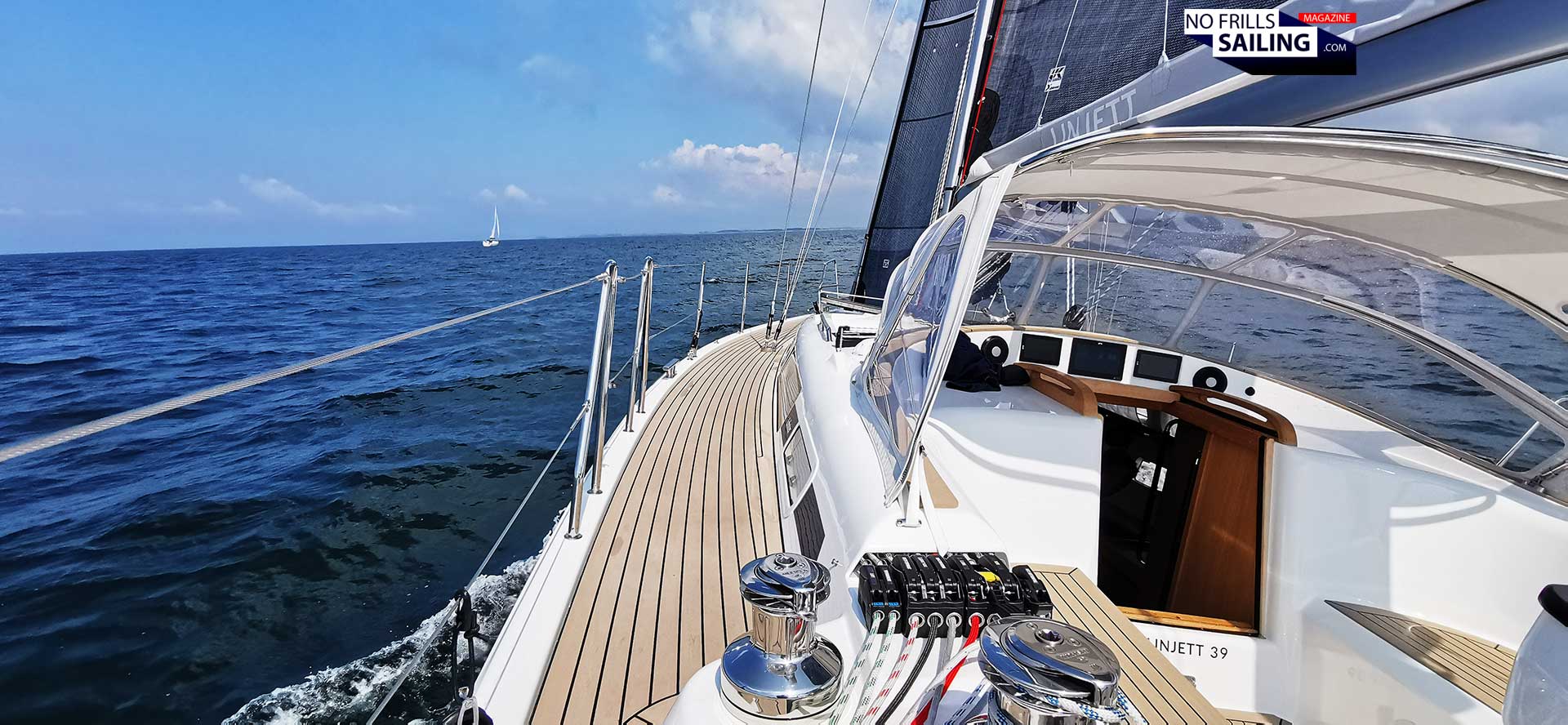
It literally takes a few minutes only to catch up to our “opponents”. That´s awesome, because Linjetts aren´t performance cruisers in any way. These boats are just the “normal” way of cruising, for Scandinavians. That´s what makes Scandinavian style cruising so attractive in my eyes: It is vacation with all comfort and amenities you can dream of, but also pretty decent quick sailing with a big emphasis on sailing fun, sails trim and feeling for the boat. Nothing on this boat feels only remotely like the usual numb impression you get from some big production cruising brands. Yes, the Linjett is not a Luffe, but she´s a hell of fun, I can confirm!
Linjett´s layout: Made for single handed sailing
While I was steering, I of course had to trim the sails a bit, which, of course, going straight upwind isn´t all too much you can do. Especially with a self-tacker. But that gave me some time to check out and review the ergonomics of the winches and running rigging layout. First of all, as you may have acknowledged already, the Linjett is equipped with high class Anderson winches.
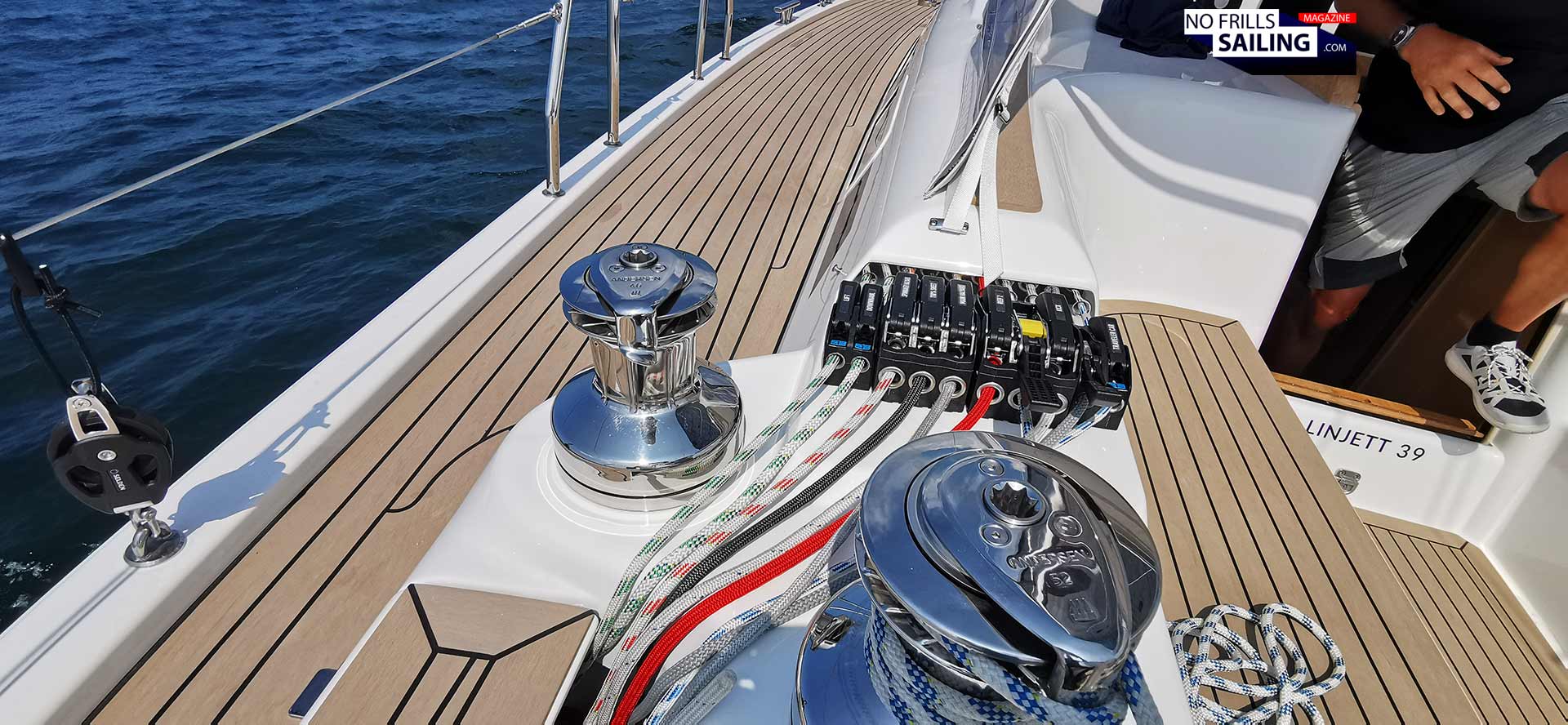
All lines are diverted aft and running below the deck: Right there at the mast foot the lines will “disappear” and reappear just in front of the impressive clavier of jammers. That said, there is no tripping hazard nor any danger of sailing guests or cockpit-users to get entangled within any sheets or rope at all. This also means that all sails controls and trimming devices are situated right in front of the steering wheels – this boat´s layout is made for single-handed sailing. Which makes sense: Most crews in this size of boat are predominantly consisting of two persons.
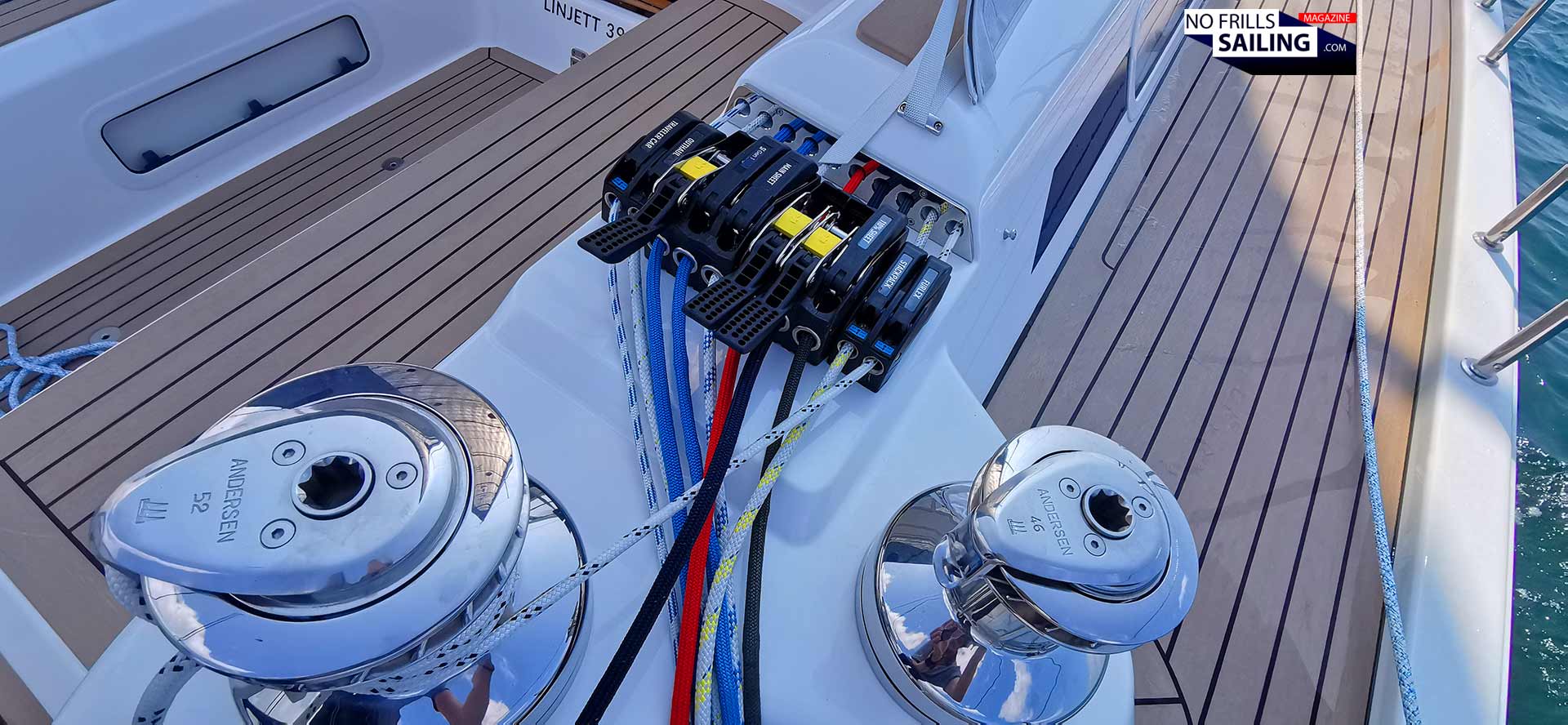
Which is mostly “Him and Her”, the classic sailing couple. For welcoming occasional guests or your kids, next to the owner´s front cabin, two large aft cabins can be offered. By the way, if you are interested in a complete walkthrough including a detailed review of the cabins, check out this article. So, mostly two persons aboard with one of them actively steering and sailing the boat. This is what the layout is made to achieve. And it does it perfectly. The mighty main 52 winches are primarily operating all sheets, reefing lines and halyards.
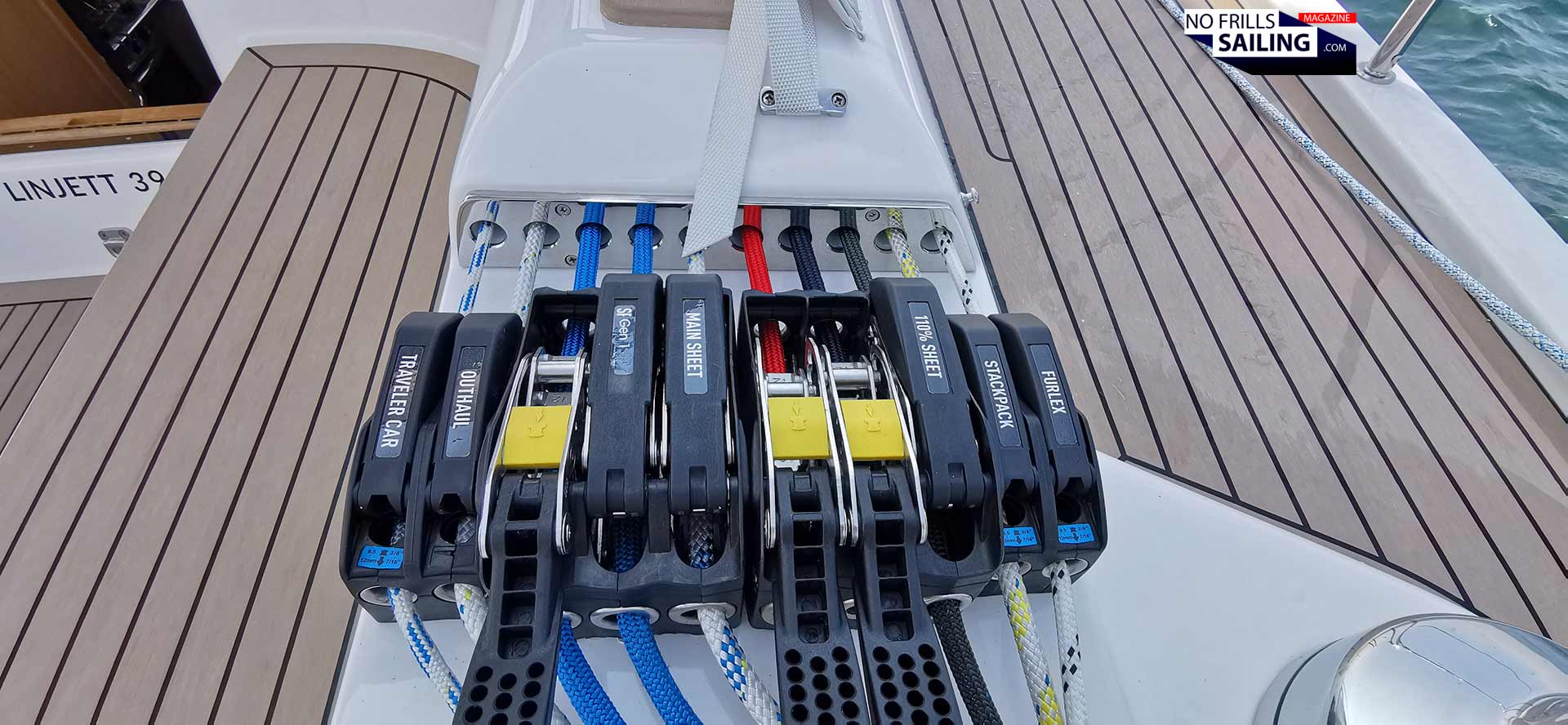
The only thing I found odd was the fact that the smaller, 46 winches, are mounted in such a way that they can only work properly for Genoa sheets of sheets of the light wind sails. Otherwise, the angle of all lines coming out of the jamming clavier is far too extreme. Thomas says he will counter this by attaching a thick ring, ropeye or fairlead just in front of the jammers to being able to utilize all four winches at the same time for the lines. Maybe that´s a hint for the shipyard to offer this fitting ex works as well.
The indescribable joys of Gennaker sailing
After some time we catched up with the Elan in front of us, it was time for the downwind section. Thomas predicted that performance would be low under standard sails and offered to take up the Gennaker. Of course I agreed and so he hauled the big sail bag on deck – Gennaker tim!
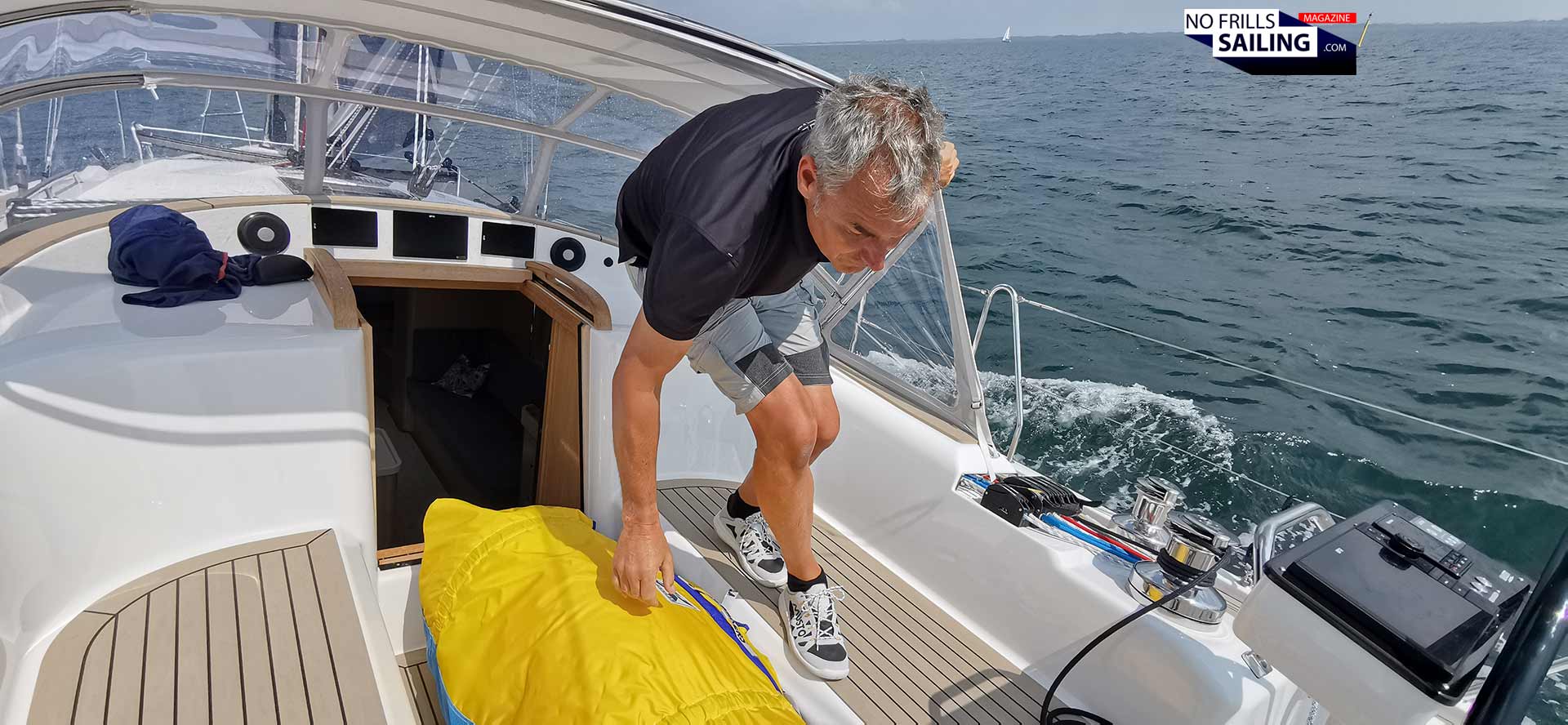
Since my first own experiences with this big light wind sail I am the greatest fan of asymmetric Spinnakers: They are easy to deploy, create such an incredible surplus of sailing performance in light wind conditions, are relatively easy to trim and control and when wind becomes too strong, retrieving the Gennaker is also a no-brainer. Provided you operate a thorough socket, like the one Thomas went for. I know what you are thinking now: There are furling Gennakers as well. Why not mention these?! I´m honest: I am more on the “keep it stupid and simple”-side here, so always pro-socket.
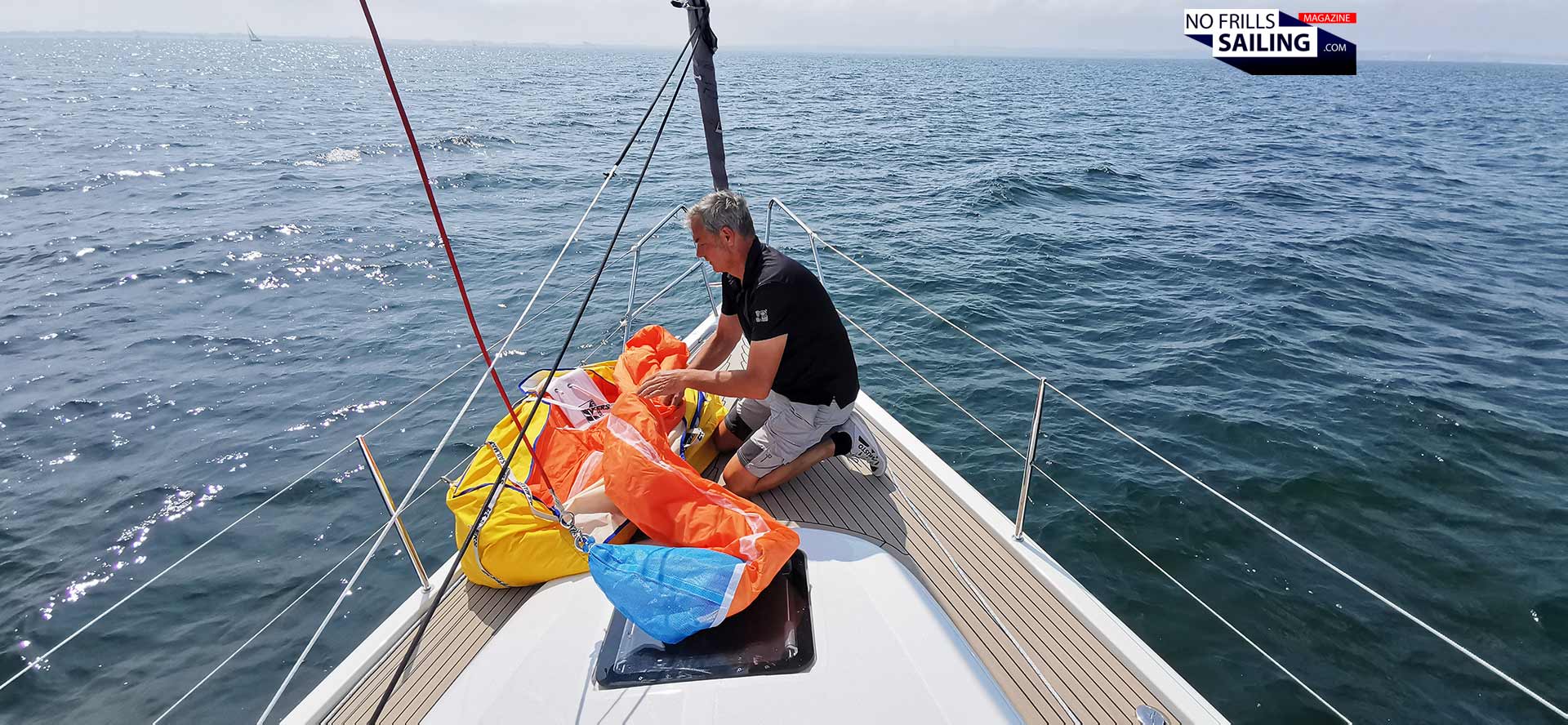
Because things can get complicated very fast, even with the easiest possible solution. A lesson we again learned pretty soon after Thomas had connected the tackline (just a provisional rope to save time, don´t be tricked by the picture) and the sheets. Upon hoisting the socket and letting the kite fly, around midway up, the line jammed. Apparently, the hoist rope got entangled in itself, causing a slight delay. Proof of concept: Even the easiest possible solutions bear enough chances for mishaps. So keep it as simple as possible, because solving those mishaps are way easier for the “Kiss”-equipment. Anyway, a minute or so later, the large blister unfolds in all its impressive beauty.
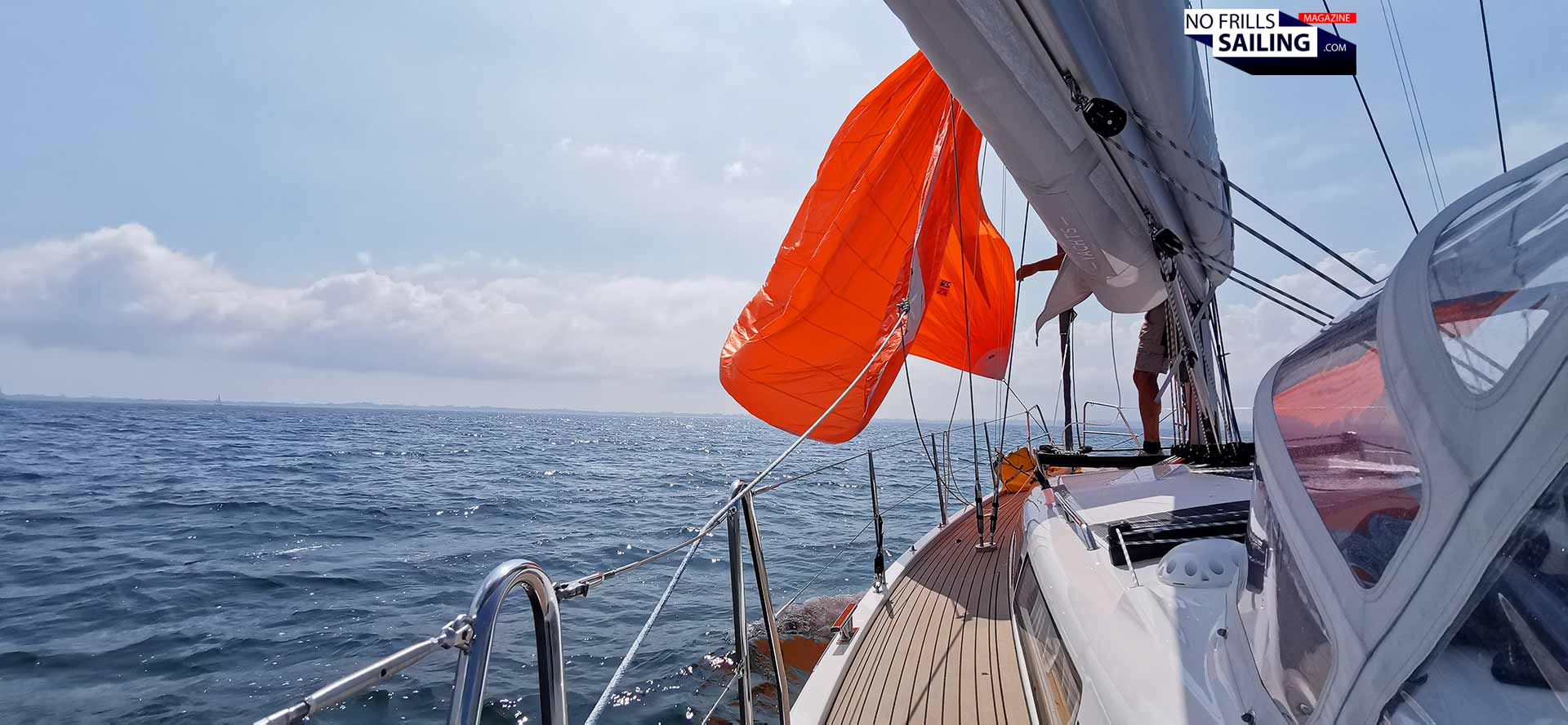
Suddenly, the boat jumps to life. She receives a strong pull as I sheet in and the Gennaker starts to become our wing. Wind is down to some 8-10 knots TWS, LOBSTER keeps a steady 7-7.5 SOG. Every time I hoist a Gennaker I am fascinated by the sheer beauty and mighty power these large, but lightweight Nylon-blisters can develop. In this, these sails will provide for almost-as-fast-as-wind speeds and are therefore from my point of view absolutely necessary gear on cruising yachts. Many sailors still seem to be kind of afraid for some reason, erroneously thinking that Gennaker-sailing is only for pro-sailors.
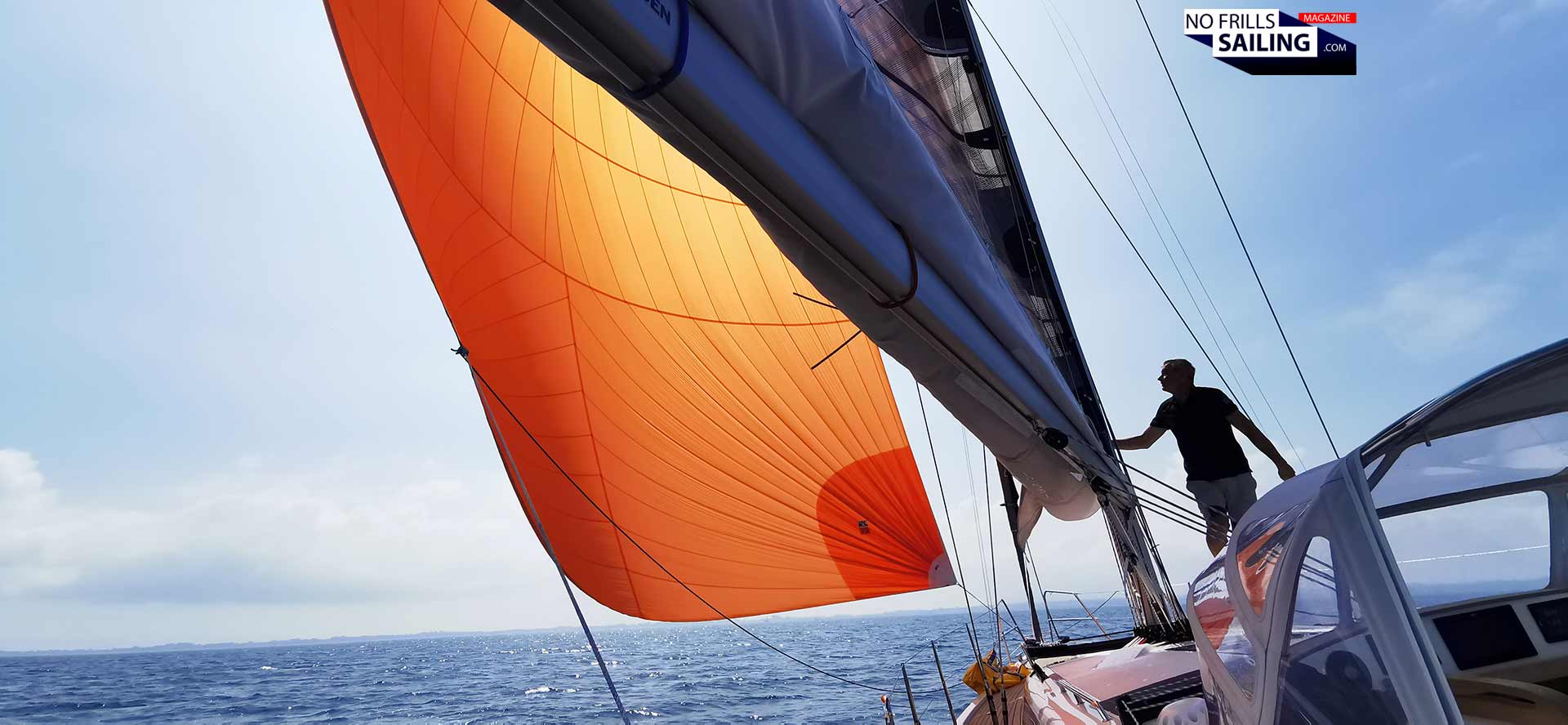
No, it´s not: It´s easy, it´s so much fun and it is convenient. But with everything connected to your boat you should opt for a trustworthy brand and decent quality both material-wise but also in terms of craftsmanship. If you are unsure of what to look out for, check this article of me visiting a sailmaker who showed me in detail what makes a good canvas, a good product and a good sail in the end.
Sailing (almost) as fast as the wind …
I really enjoyed steering LOBSTER under Gennaker. Behind me at the transom the wake we left behind was pretty impressive and I am sure if we had wanted to we could have squeezed out one, maybe two more knots in terms of speed. Thomas took over and drove her upwind almost to the point where a Gennaker cannot sustain its drive and when a Code 0 comes into play – impressive how versatile modern day sails can be! I reclined on the cockpit bench, seeking some shade and admired this wonderful setting: If it was for me, we could have laid in a course to Sweden and just go on forever like this. It´s pure bliss.
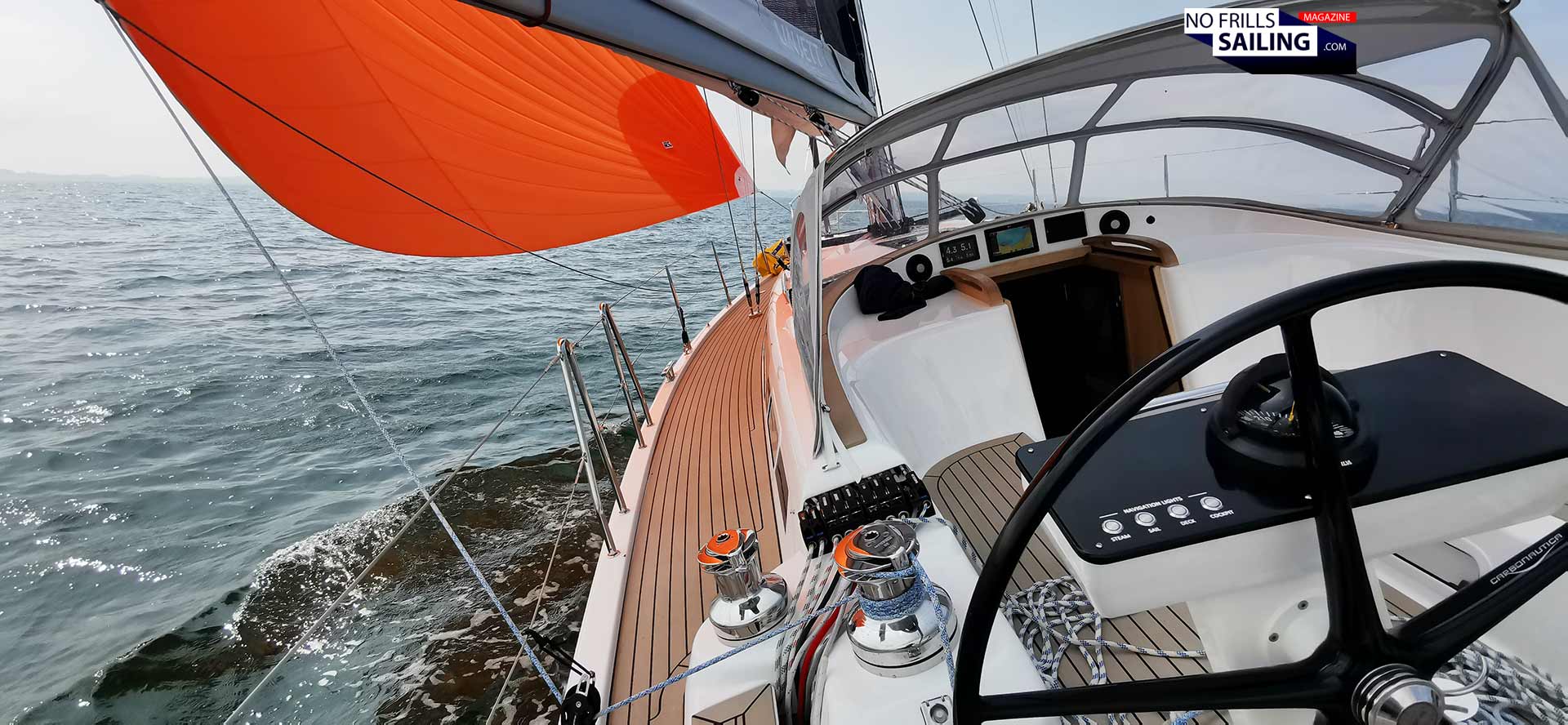
Speaking of having a bliss: How does this yacht feel in terms of comforts? Well, honestly, we lacked a bit more sea state. With waves less then a few centimeters the Linjett that day behaved absolutely gorgeously, but I´d hade like to drive her into some steeper waves and also get a feel for her movement on different points of sails. This wasn´t possible because, frankly, it was a 10 out of 10 perfect summer´s day. So, from what I´ve witnessed during out session out, I have only praise for the Linjett: The hull design makes for a nice, gentle, steady up and down. No shaking, no beating- she just moves very gently through the water.
It´s so quiet down below
Which is a trademark of Scandinavian style yachts: Their width is comparatively slim in regard to Mediterranean style boats. Also, these yachts usually do not carry the full width to the transom, offering a slightly more classic hull shape. That said, motion through the water especially in more violent waves is usually considered more gentle. There are far better experts in hull design as me, for example, Paolo of the Interesting Sailboats-blog made two very, very in-depth articles about classic hulls vs. modern hulls, it´s really worth a read, click here.
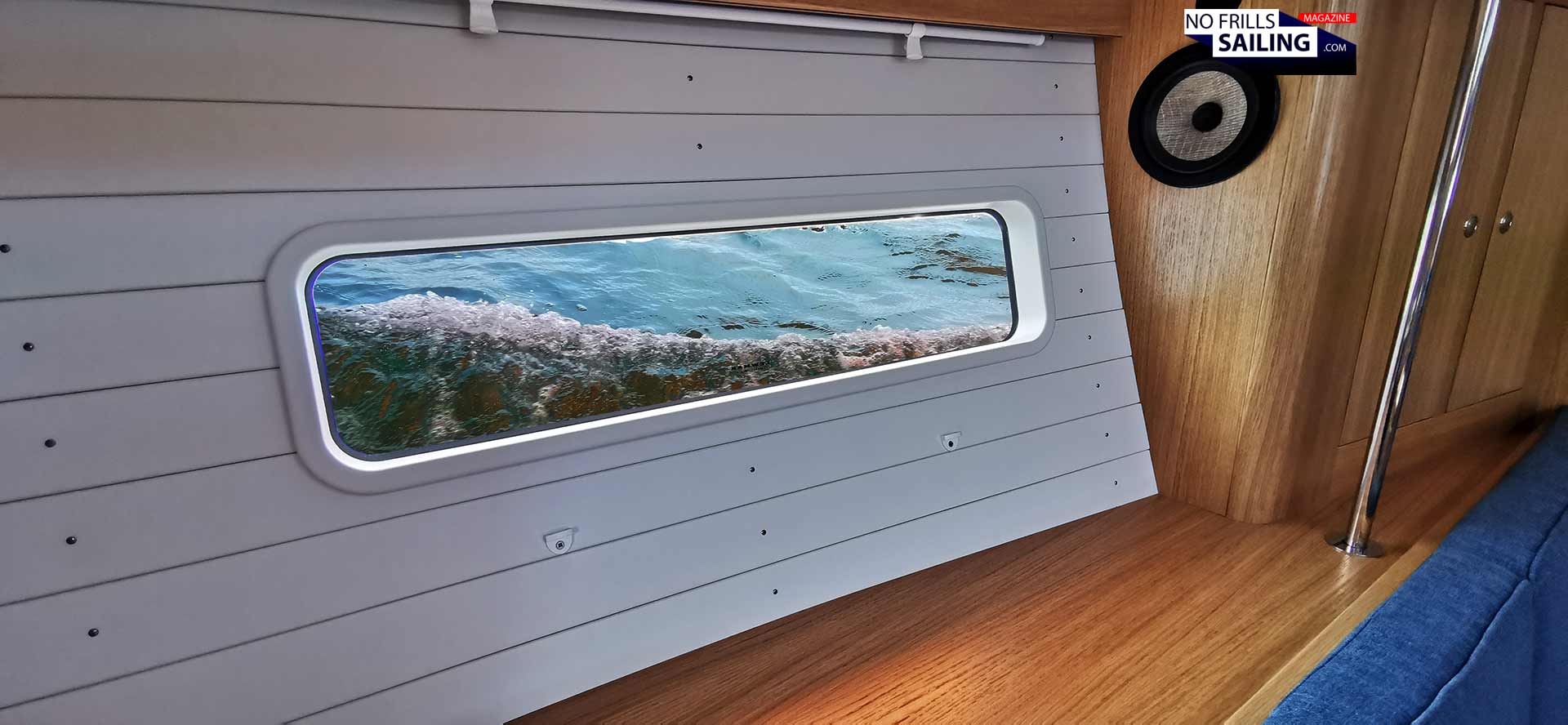
For what I can say, I´m in for the Scandic boats when it comes to overall performance and comfort, I´m in for Med-style yachts when it comes to sexiness and making the most out of your vacation. But back to LOBSTER: As I went down to check how the interior is like when the boat is underway, again, I was enchanted by the sheer quality of woodworks on the Linjett. I don´t want to rhapsodize all too much about the quality of the furniture here as I have made an article on this matter as well, check it out here. Nevertheless, it´s always so rewarding to see yachts made like this.
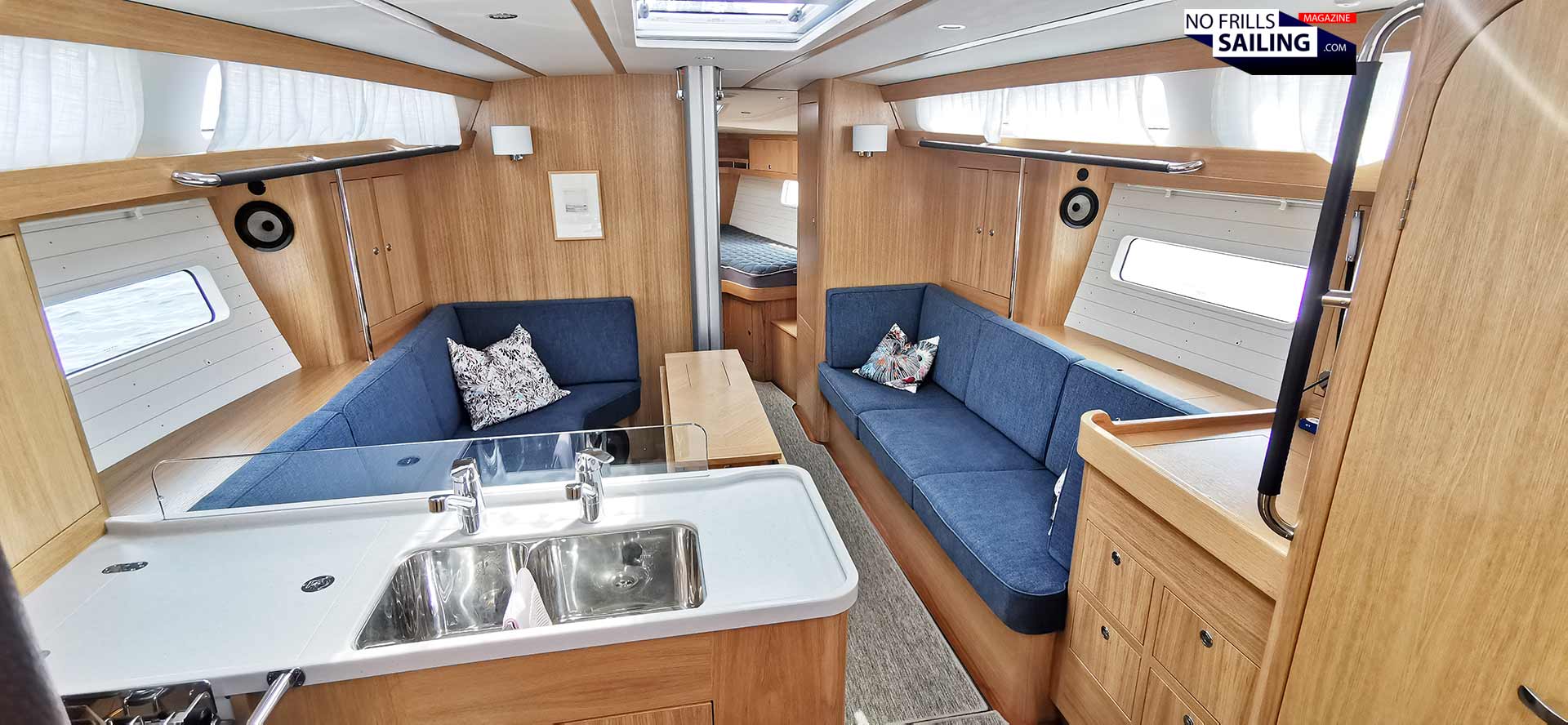
The interior of LOBSTER is made in light Scandinavian Oak. It´s very classic, very “maritime” in terms of colors and the feel to it. Thomas refrains to put in all too much of decorative stuff. Definitely a plus: You may know as well some people who have pictures of their cats nailed the bulkheads, right? Although the drapes were still closed for all coachroof windows, the seascape hull-windows and large skylights made for a very light-suffused, welcoming atmosphere. Of course, you could hear the water flushing by the hull, but again: No slamming, no plunging down. And also: No squeak, no groan and no ”plastic boat noise” whatsoever. That´s a sign for something, right?
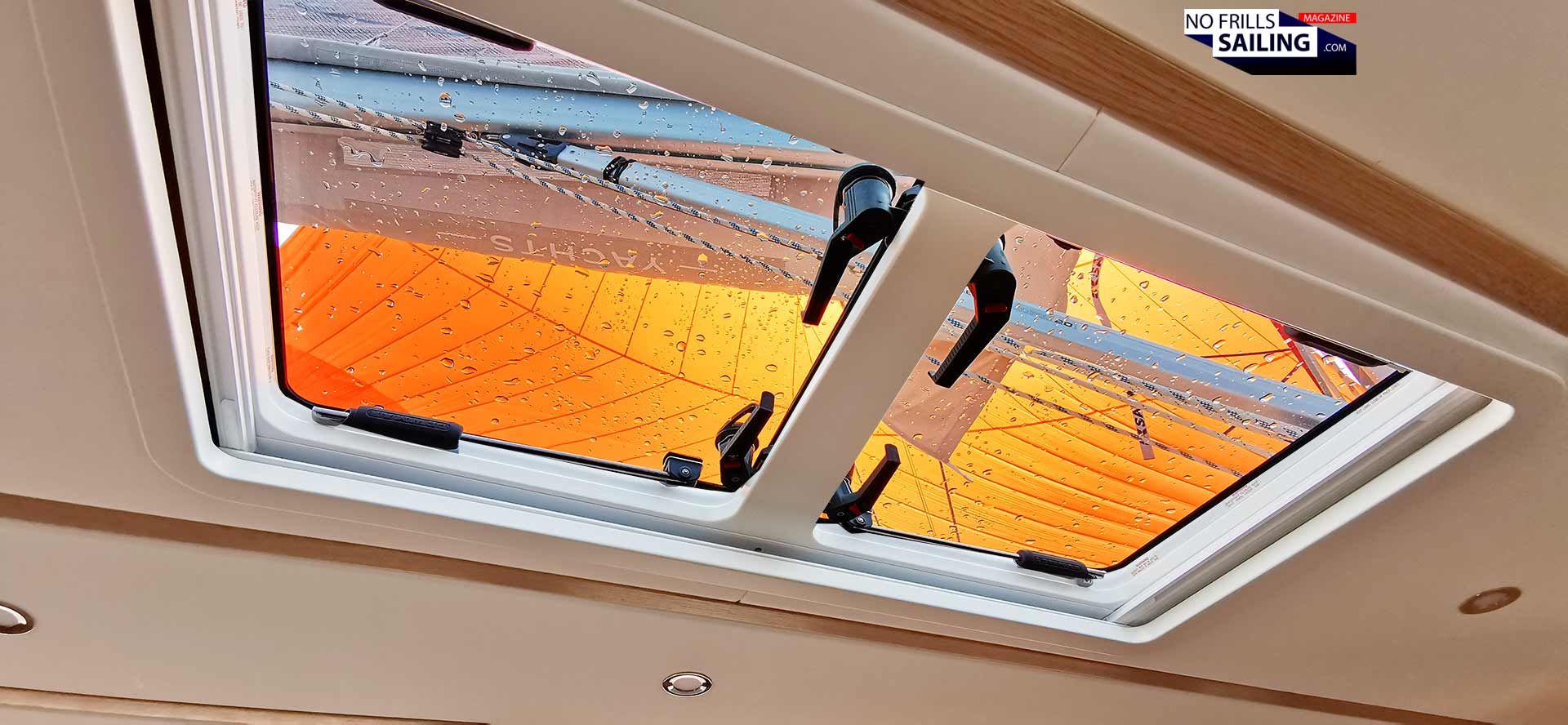
The picture above shows the view I loved the most: The Linjett 39 comes with two large skylights. Two opening hatches (of course in different directions so that always fresh air can enter the salon, no matter the wind direction) with a large glass surface area. The cheerful orange color of the Gennaker shining through, making for a very special lighting inside the boat. No, you don´t feel like being down in the basement here, it´s a nice, lush and very relaxed atmosphere.
… we could have sailed on forever.
As I mentioned before, as it was not only a perfect day to sail, it was a perfect boat to enjoy this day out. It´s funny, but right away, almost to the day one year before in June 2024 I visited the Linjett 39 for the first time. I had never heard of this brand before, having thought that Arcona Yachts was the “secret hidden champion” of contemporary Swedish cruising yachts. Well, as Arcona chose to become more “modern” after the sad passing of Stefan Qviberg under new ownership of Najad Yachts, Linjett, in my opinion, is the last Swedish boat maker upholding these classy values.

Of course you can “spice up” your Linjett if you like: There´s a new integrated bowsprit available now (I´ve written about it here) that allows for a wider choice and a slightly more powerful light wind sails-setup, for example. But nonetheless, I am about to renew my pledge from back in 2024: This may be one of the most perfect 40-feet cruising yachts I´ve seen so far. Surely a dream yacht, surely a boat suitable for extended couple cruising and also long haul-sailing.
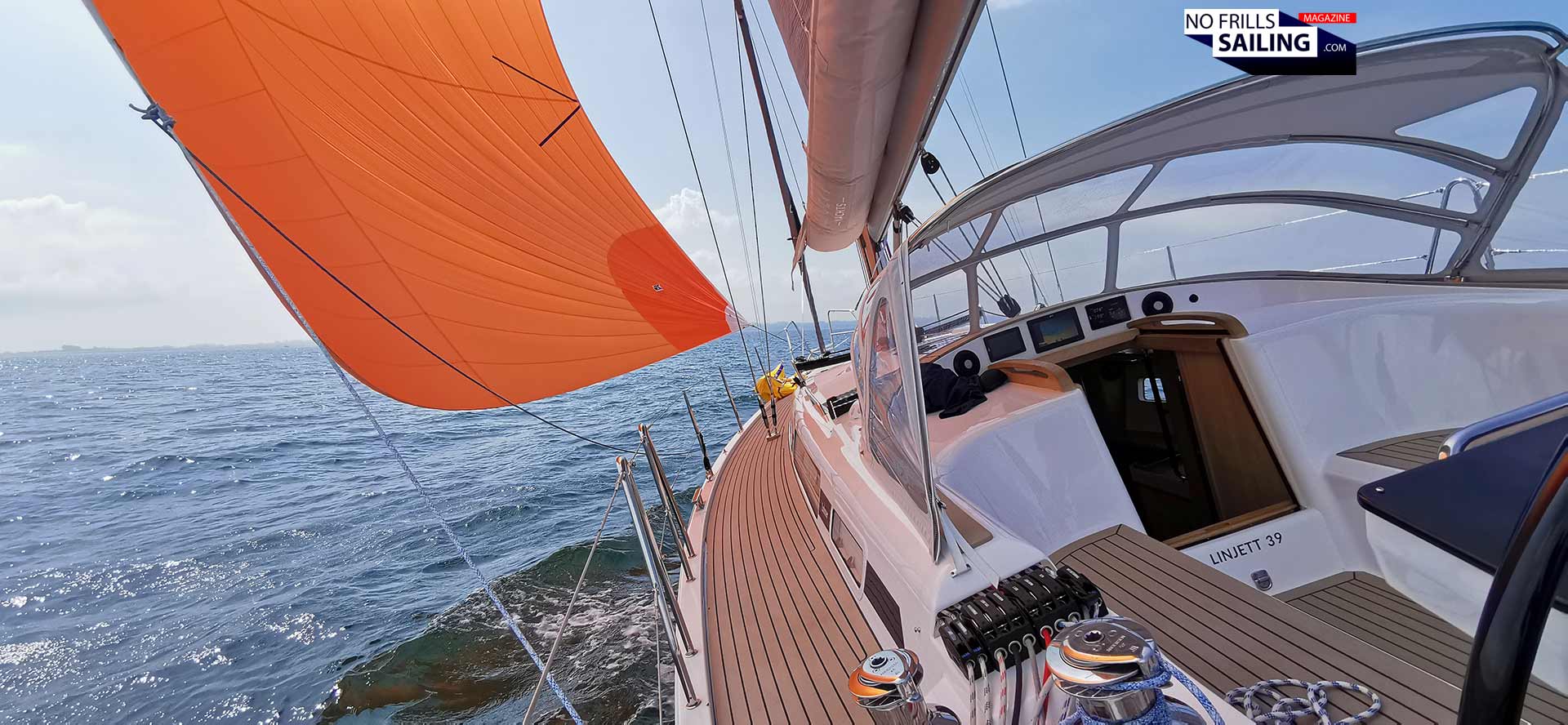
But even the most perfect occasion has to end some way or another. As for Thomas and me, it was a family appointment (probably having a nice coffee with your traditional cake in the afternoon, that made him set a course back to the marina. Thanks to our orange kite, we soon thereafter arrived. Thanks to his more than perfect berthing situation we had her back in her box and tied up safely in no time. Packing the main sail, closing the lazy bag and putting out the fenders – what a wonderful day out!
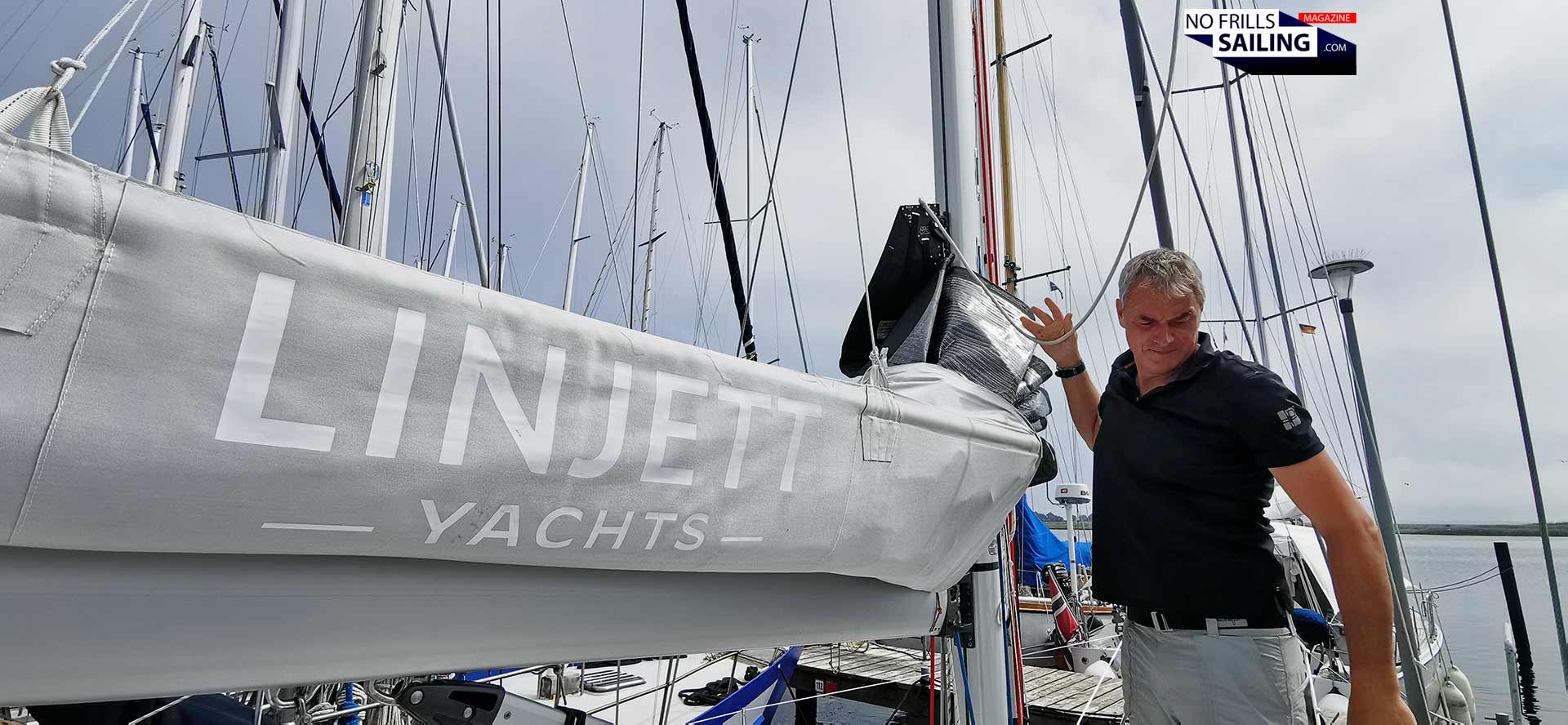
Thomas owns and runs a marina “around the corner” in the Luebeck Bay himself. As he lives in Holy Harbor, it´s practical to keep the boat here. But as he is a maritime professional himself, offering the full shipyard-service range, berths, winter storage and such, he offered to Linjett becoming a service hub for their clients from now on. Which he is no: Official partner for Linjett Yachts here in Germany, or in the southwestern Baltic area. That said, one now understands why LOBSTER was in such a pristine condition, even after two seasons of use.
A beautiful, classy yet modern cruiser
I look back a last time upon saying Goodbye to Thomas. The Linjett 39 convinces all along the line. This yacht ticks all the boxes if you look for a decent performer in terms of sailing performance, combined with all amenities and luxuries your seek in a cruising yacht. She is definitely not a bargain: Specced like Thomas´ yacht, a Linjett 39 will surely hover around 600.000 to 700.000 Euros these days, but as I have also stated in an article about the finishing quality of Linjett: Quality has its price. This is definitely a boat worth considering as your “last boat”. Or maybe even as your first, if you seek uncompromised quality and finish.
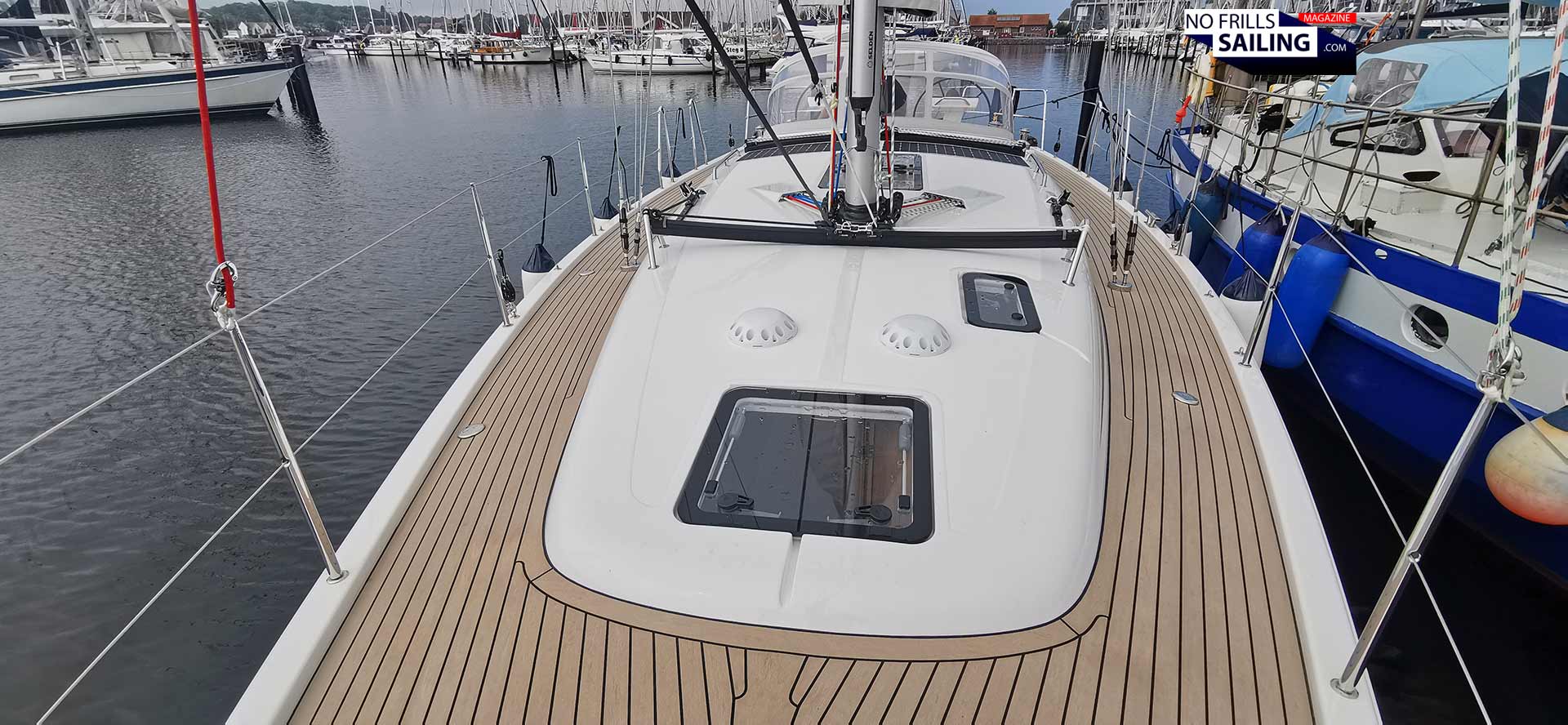
As much as I personally love the flat, carbon all-out racing yachts, all these planing cruisers, foilers and state-of-the-art one offs: Thinking of taking my beloved wife and my kids on a perfect sailing vacation, with lush days transversing long legs alternating with days at anchor in a quiet marina or tied up to a solitary island in the Swedish archipelago, well, that´s surely not a Pogo or Solaris I have in mind. It´s a boat like this.

With only a very, very few details worth some upgrading or retrofitting, the only “big” thing I completely disliked was the Flexi Teak used for the deck material. I am pro wooden-substitutes, but there are other materials out there which make a far better look in my opinion than this, check out what I have chosen for my own new boat in this regards. Other than that – and it´s really just a very subjective matter of my very own taste – this Linjett 39 pretty much is what I haven insinuated one year ago: Probably the perfect 40-footer!
Thanks Thomas, for that wonderful sailing day out! I hope I haven´t interrupted your precious weekend all too much.
Here´s more on Linjett yachts and the lure of Scandinavian style sailing:
Browse all Linjett articles by clicking on the hashtag #linjettyachts
What´s it all about – Scandinavian style sailboats?
Check out a true Swedish icon: The Omega 42
